HISTART 10 midterm
1/69
Earn XP
Name | Mastery | Learn | Test | Matching | Spaced |
|---|
No study sessions yet.
70 Terms
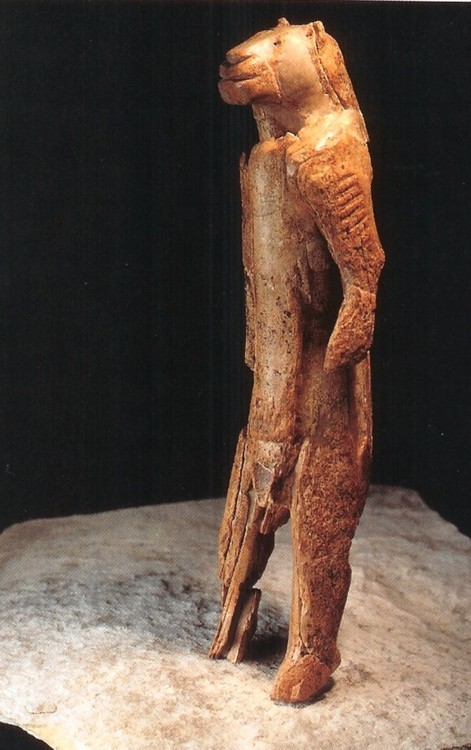
Human with feline head, Germany, 30000-28000 BCE (Paleolithic)
> shows tool use and imagination
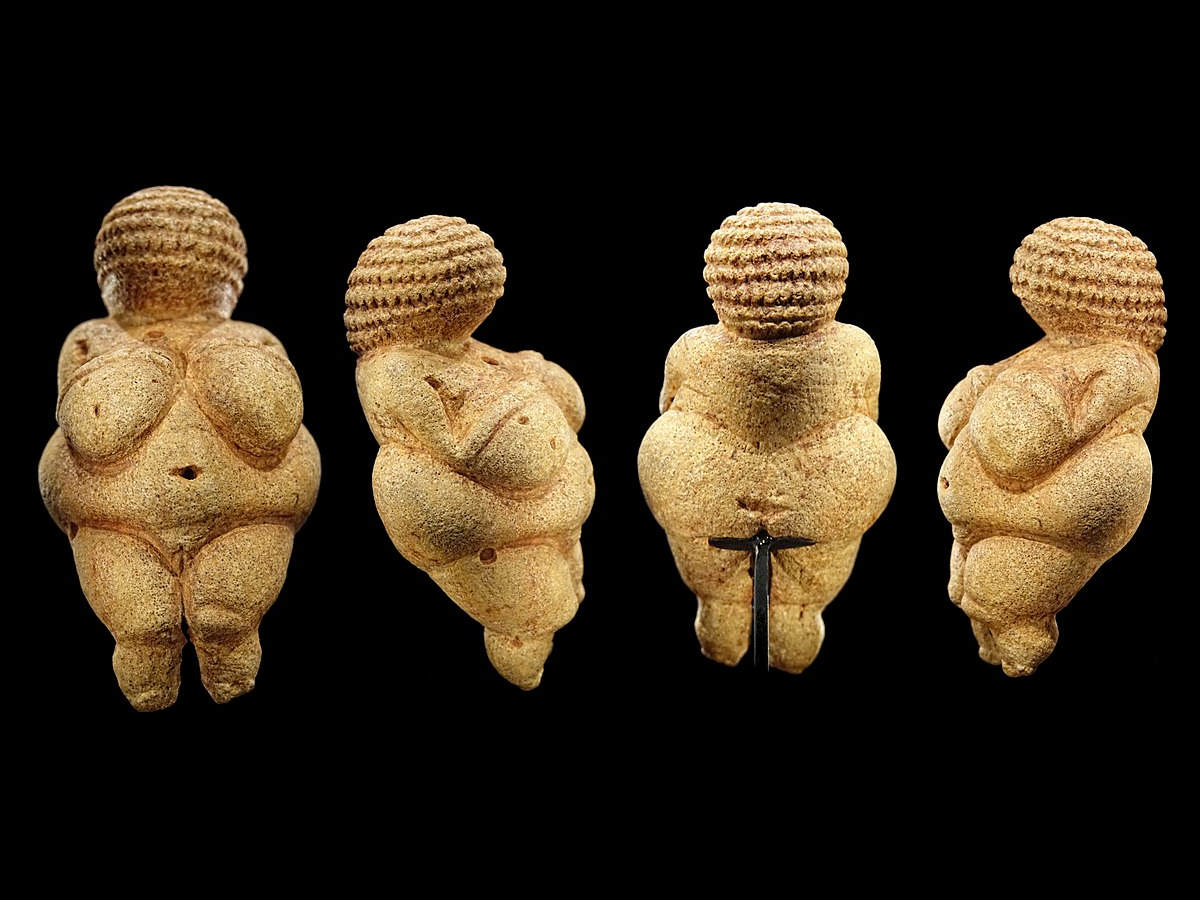
Nude woman (Venus of Willendorf), Austria, 28000-25000 BCE (Paleo)
> emphasis on female anatomy, reproductive features, fertility, pregnancy
> no facial features
> one of hundreds of these figures
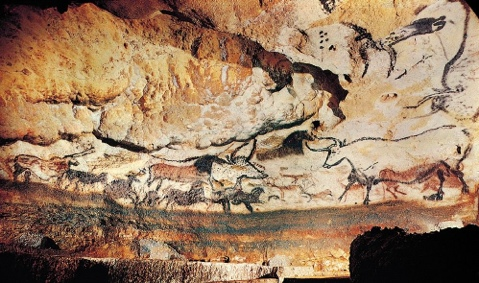
Hall of the Bulls, Lascaux, France, 16000-14000 BCE (Paleo)
> twisted perspective/composite view (profile body, frontal horns)
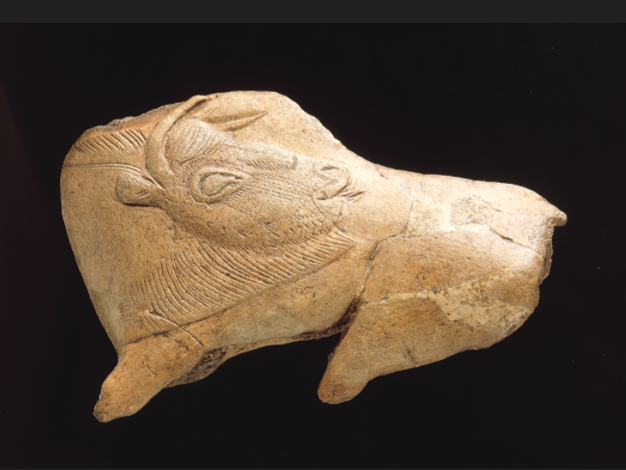
Bison licking its flank, Saint Germaine, 12000 BCE (Paleo)
> fragmentary spear thrower
> unusual departure from standard poses to fit material
> controlled lines
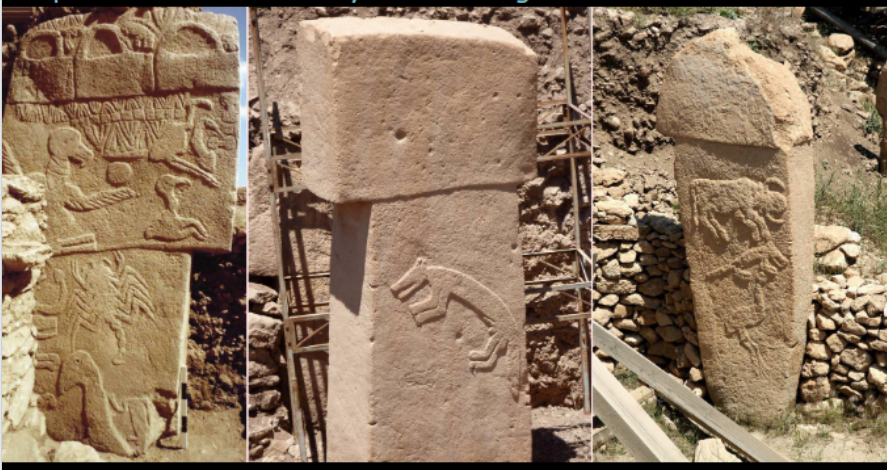
Neolith temple with animal reliefs, Gobekli Tepe (Turkey), 9000 BCE (Neolithic)
> created by hunters and gatherers before advent of permanent villages
> first lasting evidence of collective community in “pre-villages”
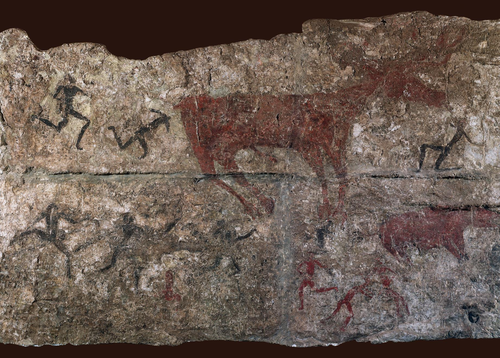
Deer hunt wall painting, Catal Hoyuk (Turkey), 6000 BCE (Neolithic)
> HUMAN FIGURE
> brush use, different pigments for different subjects
> shows use of organized parties in hunting
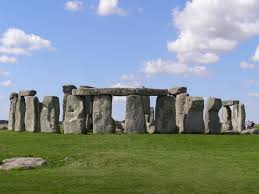
Stonehenge, England, 2550-1600 BCE (Neolithic)
> megalithic
> unknown purpose — ritual use, observatory, funerary?
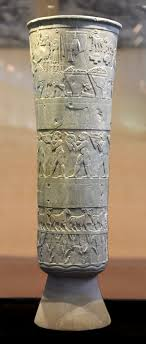
Warka Vase, Warka/Uruk/Iraq, 3300 BCE (Sumerian period of Mesopotamia)
> first great known work of narrative relief sculpture
> registers
> hierarchy of scale
> twisted perspective

The White Temple, Uruk/Iraq, 3300 BCE (Sumerian Mesopotamia)
> monumental architecture (mud brick)
> built upwards for proximity to divinity
> temple at top = god reveals himself there
> not a ziggurat
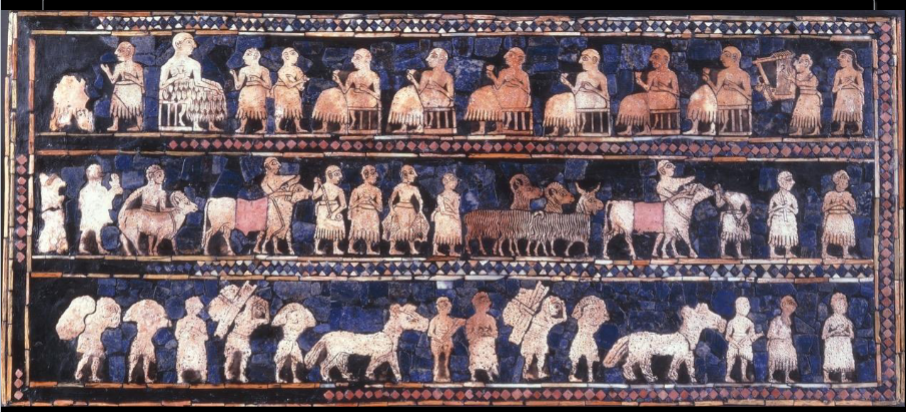
Standard of Ur “peace side,” Ur/Iraq, 2600 BCE (Sumerian Mesopotamia)
> registers
> hierarchy of scale
> depicts banquet and bounty
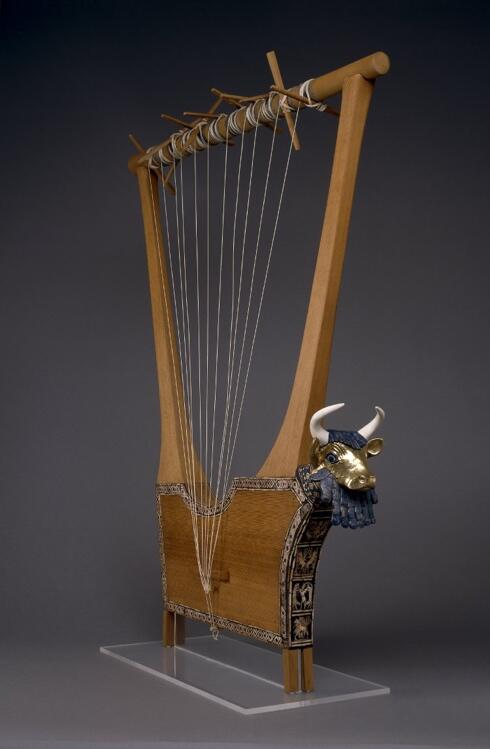
Bull-headed harp, Royal Cemetary at Ur, 2600-2400 BCE (Sumerian Mesopotamia)
> Puabi’s tomb, if that’s important idk why i’m even adding this
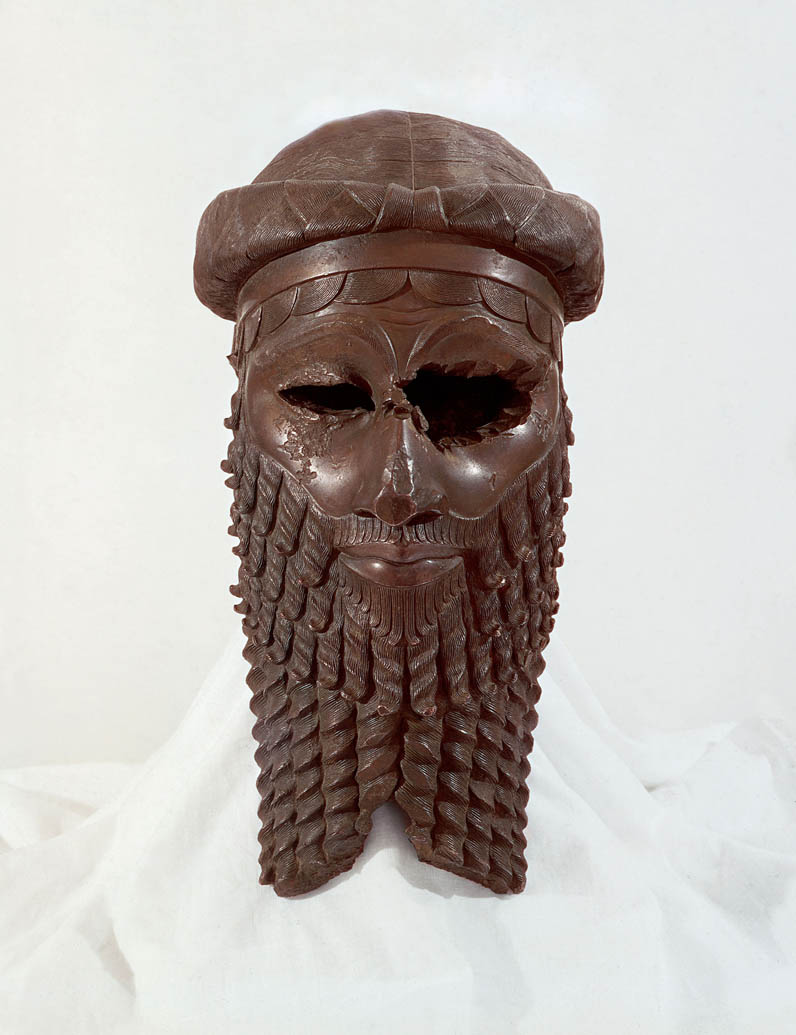
Head of an Akkadian Ruler, Iraq, 2250-2200 BCE (Akkadian period of Mesopotamia)
> oldest known fully hollow metal-cast sculpture
> defaced in antiquity
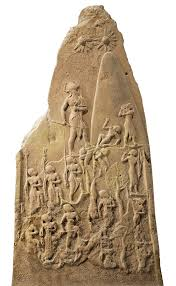
Victory stele of Naram-Sin, Susa/Iran, 2254-2218 BCE (Akkadian Mesopotamia)
> no registers — more organic composition
> hierarchy of scale
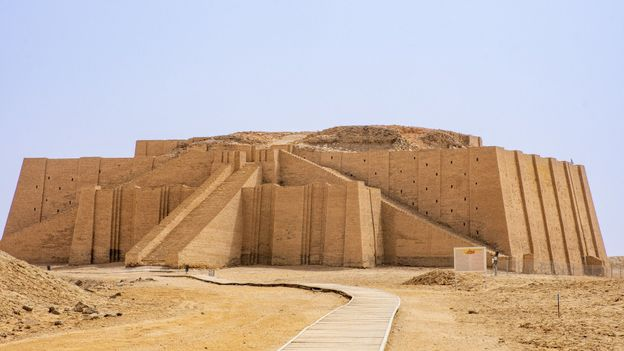
Ziggurat, Ur/Iraq, 2100 BCE (Neo-Sumerian period of Mesopotamia)
> most extant Neo-Sumerian surviving monument
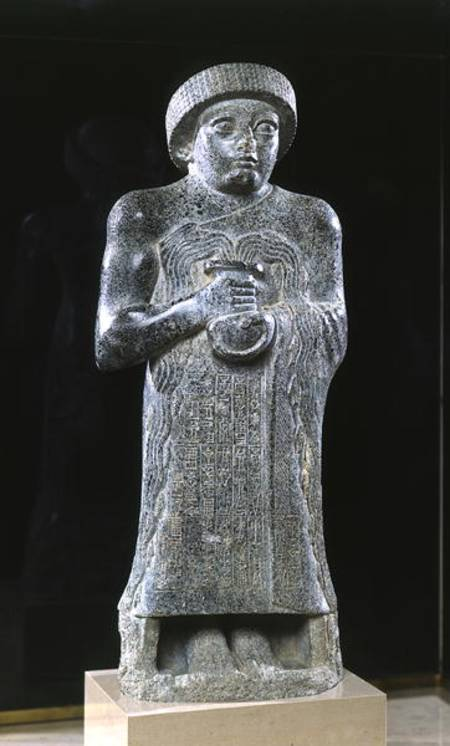
Gudea standing, Girsu/Iraq, 2100 BCE (Neo-Sumerian Mesopotamia)
> holding overflowing water jar = providing life, abundance (godly)
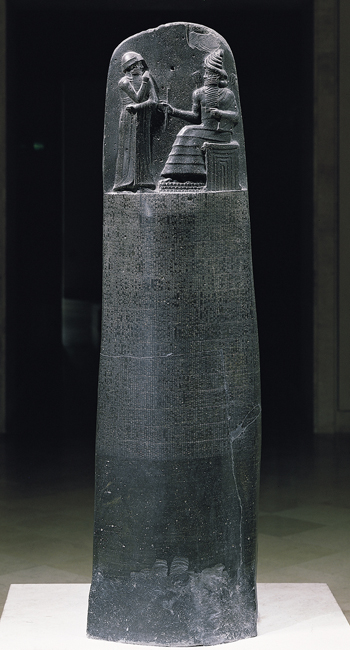
Stele of Hammurabi, Iraq, 1780 BCE (Neo-Sumerian Mesopotamia)
> twisted perspective
> covered in cuneiform laws and penalties
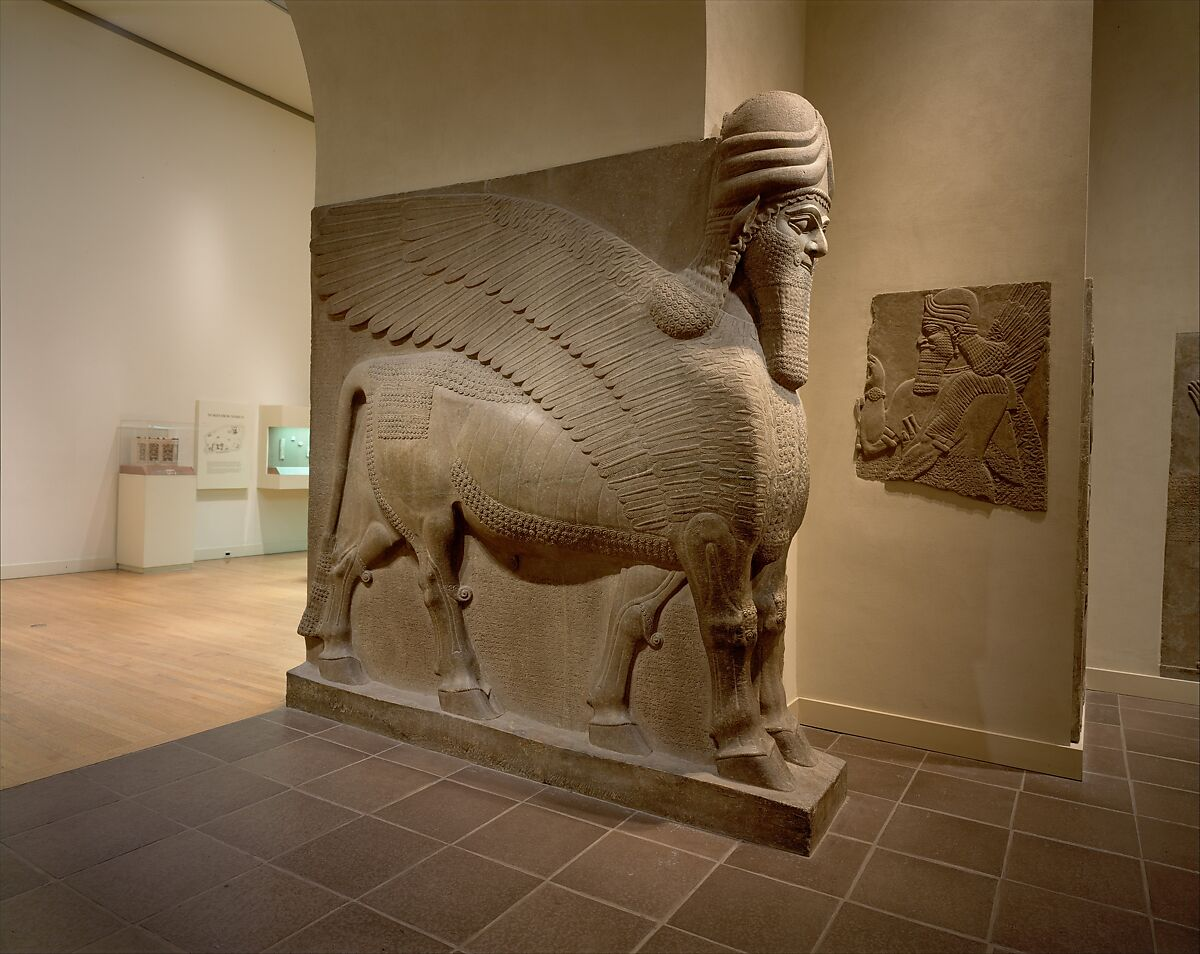
Lamassu, Iraq, 720-705 BCE (Assyrian and Neo-Babylonian Period of Mesopotamia)
> massive. 14’ tall
> warding off evil, regal protection
> would have been painted brightly
> two legs from front, four from side, five in all
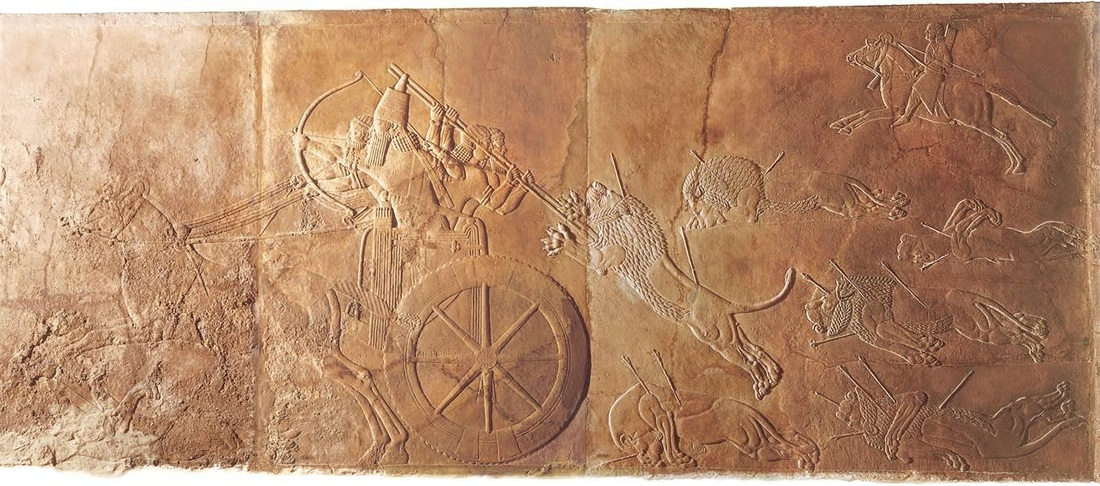
Ashurbanipal hunting lions relief, Nineveh/Iraq, 645-640 BCE (Assyrian/Neo-Babylonian Mesopotamia)
> hunting as royal virtue, human power over nature
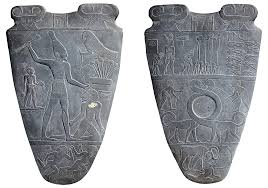
(left = back, right = front)
Palette of King Narmer, Egypt, 3000-2920 BCE (Predynastic)
> established mace pose, composite view, hierarchy of scale, registers as Egyptian conventions
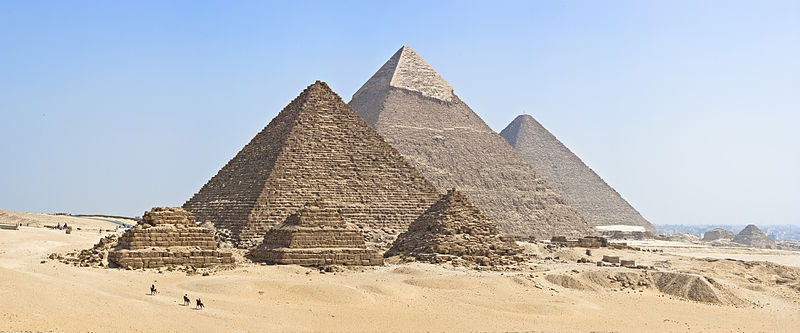
Great Pyramids, Gizeh/Egypt, 2551-2472 BCE (Old Kingdom)
> tombs for Menkaure, Khafre, and Khufu
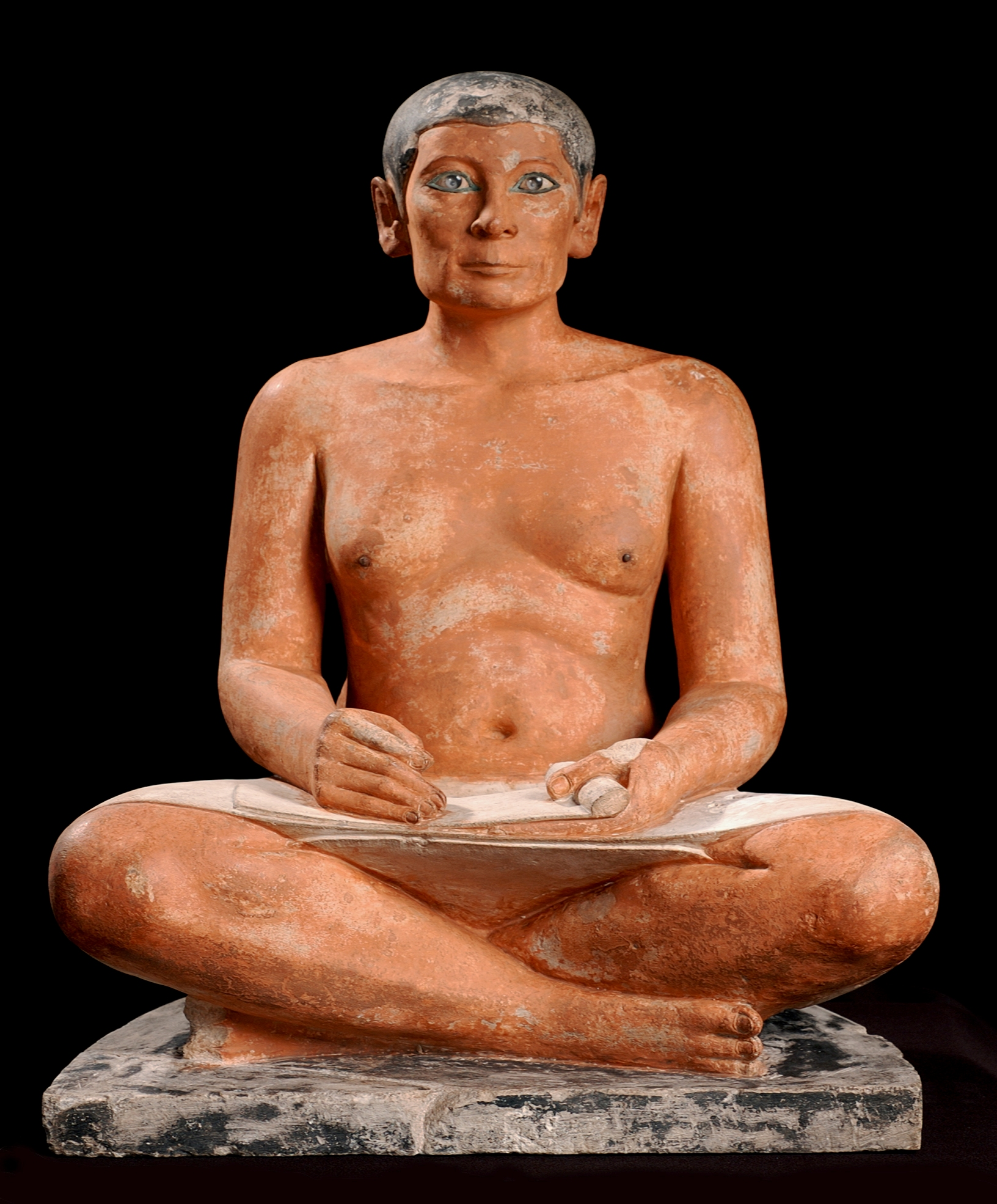
Seated Scribe, Egypt, 2500 BCE (26th century) (Old Kingdom)
> unconventionally not idealized
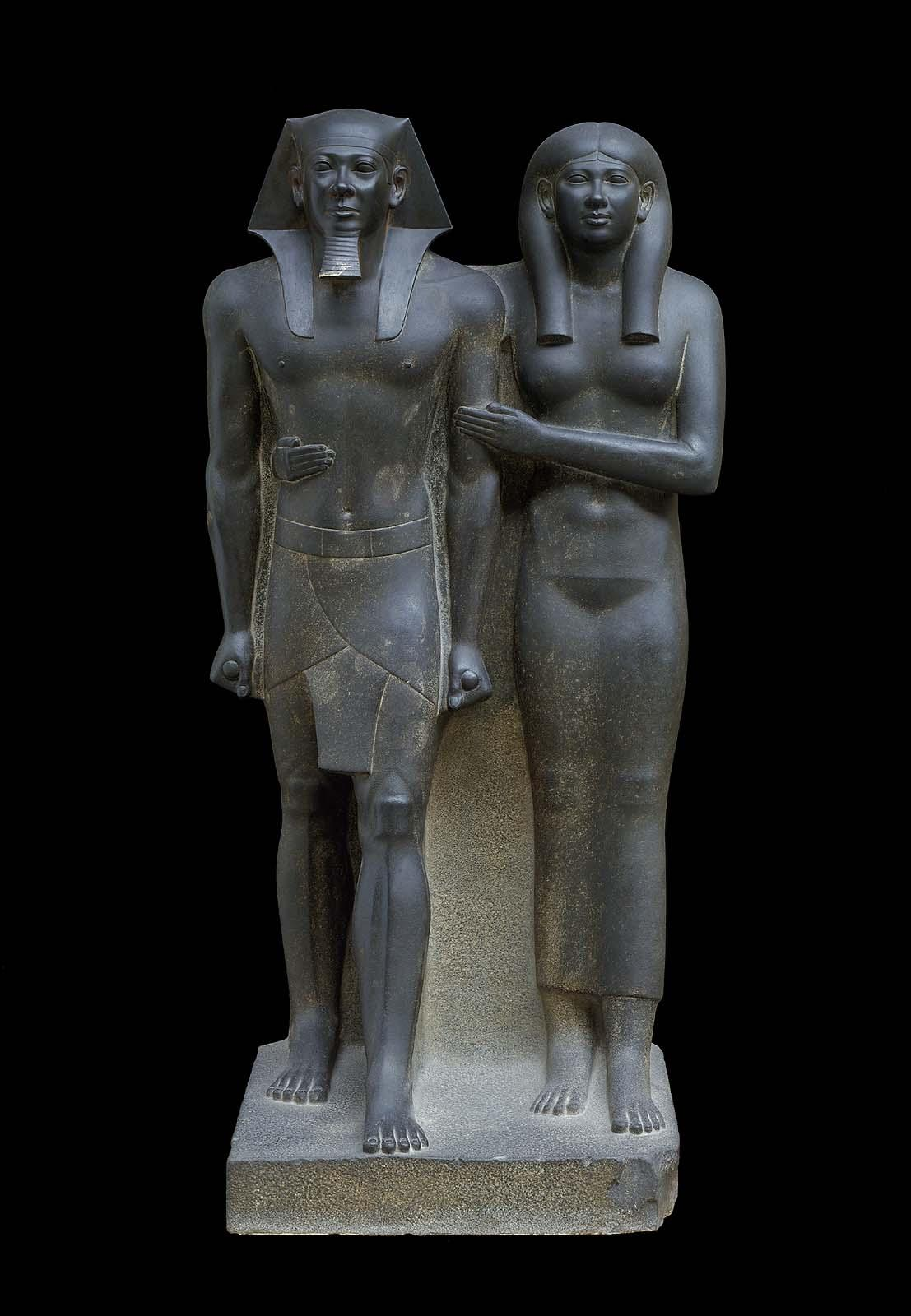
Statue of Menkaure and Khamerenebty, Gizeh, 2490 BCE (Old Kingdom)
> rigid, frontal, no redistribution of weight
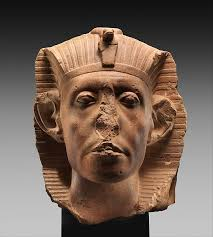
Head of Senusret III, Egypt, 1860 BCE (Middle Kingdom)
> unconventional realism and age
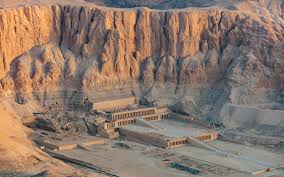
Mortuary temple of Hatshepsut, Egypt, 1473-1458 BCE (New Kingdom)
> transforms landscape into manmade monument
> colorful statues of Hatshepsut
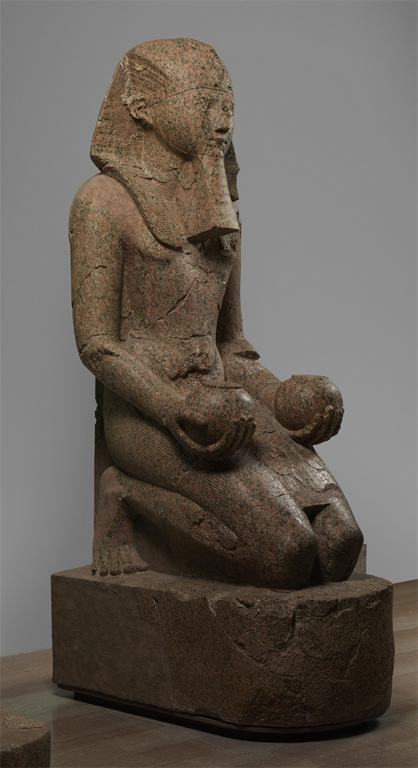
Hatshepsut with offering jars, Egypt, 1473-1458 BCE (New Kingdom)
> placed in front of mortuary temple next to Amun sanctuary
> kneeling as pharaoh only for gods
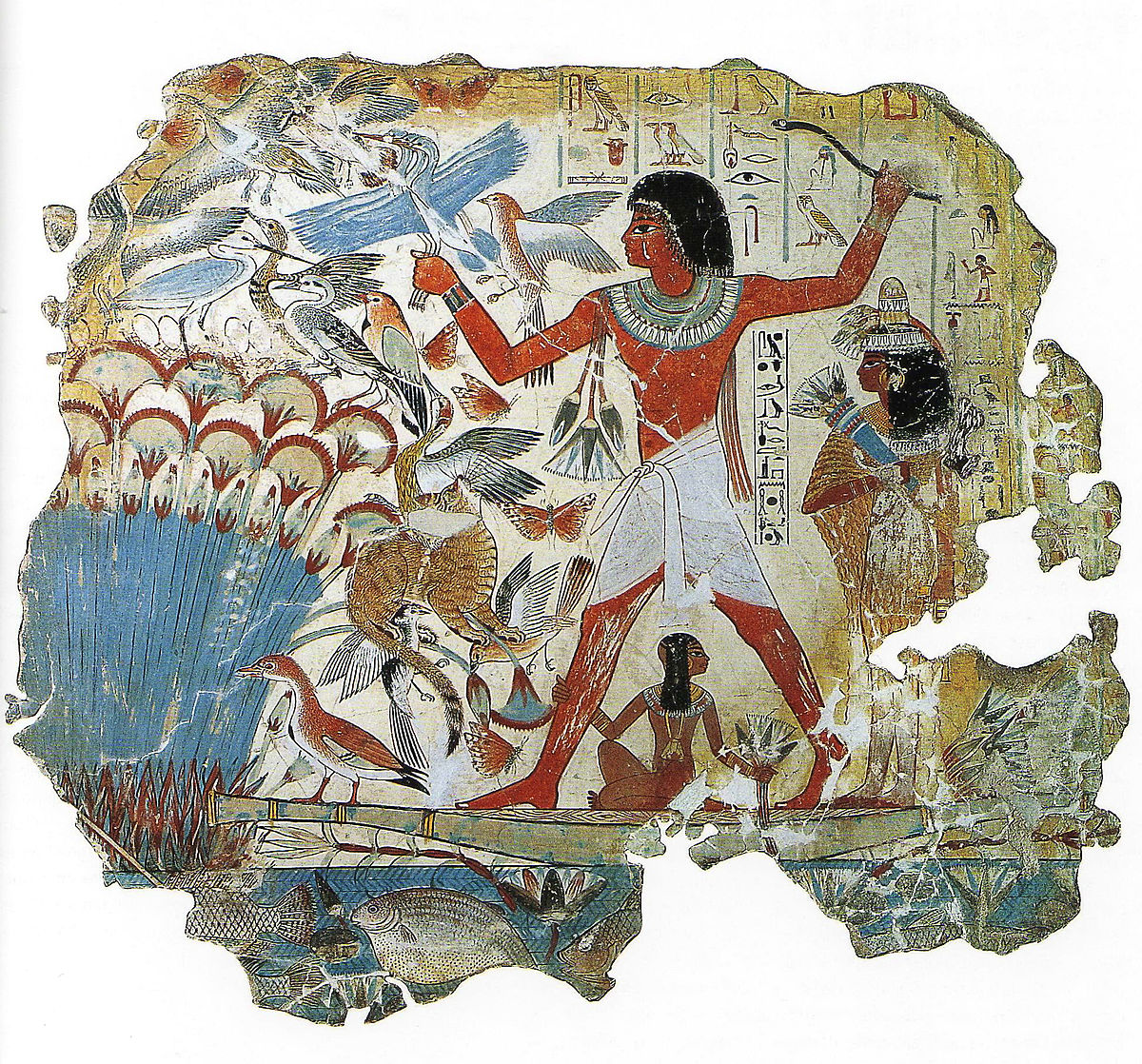
Fowling scene at Tomb of Nebamun, Thebes/Egypt, 1400-1350 BCE (New Kingdom)
> fresco secco
> composite view
> view of scribe in afterlife, surrounded by abundance and family
> inscription says he’s enjoying beauty
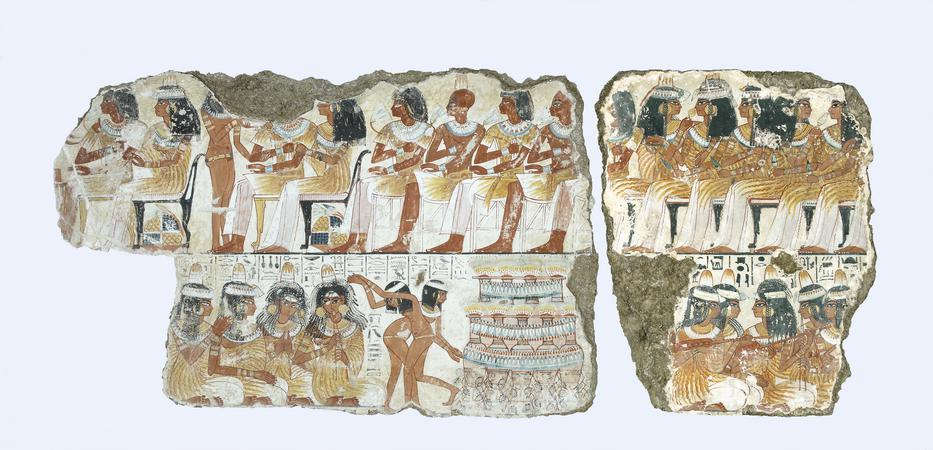
Funerary banquet from Tomb of Nebamun, Thebes/Egypt, 1400-1350 BCE (New Kingdom)
> artist attempts front view
> overlapping, complicated poses
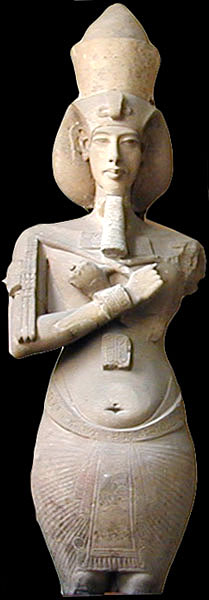
Akhenaton, from temple of Aton, Karnak/Egypt, 1353-1335 BCE (Amarna Period)
> extremely different — elongated face, drooping belly, curvy body
> 13’ tall
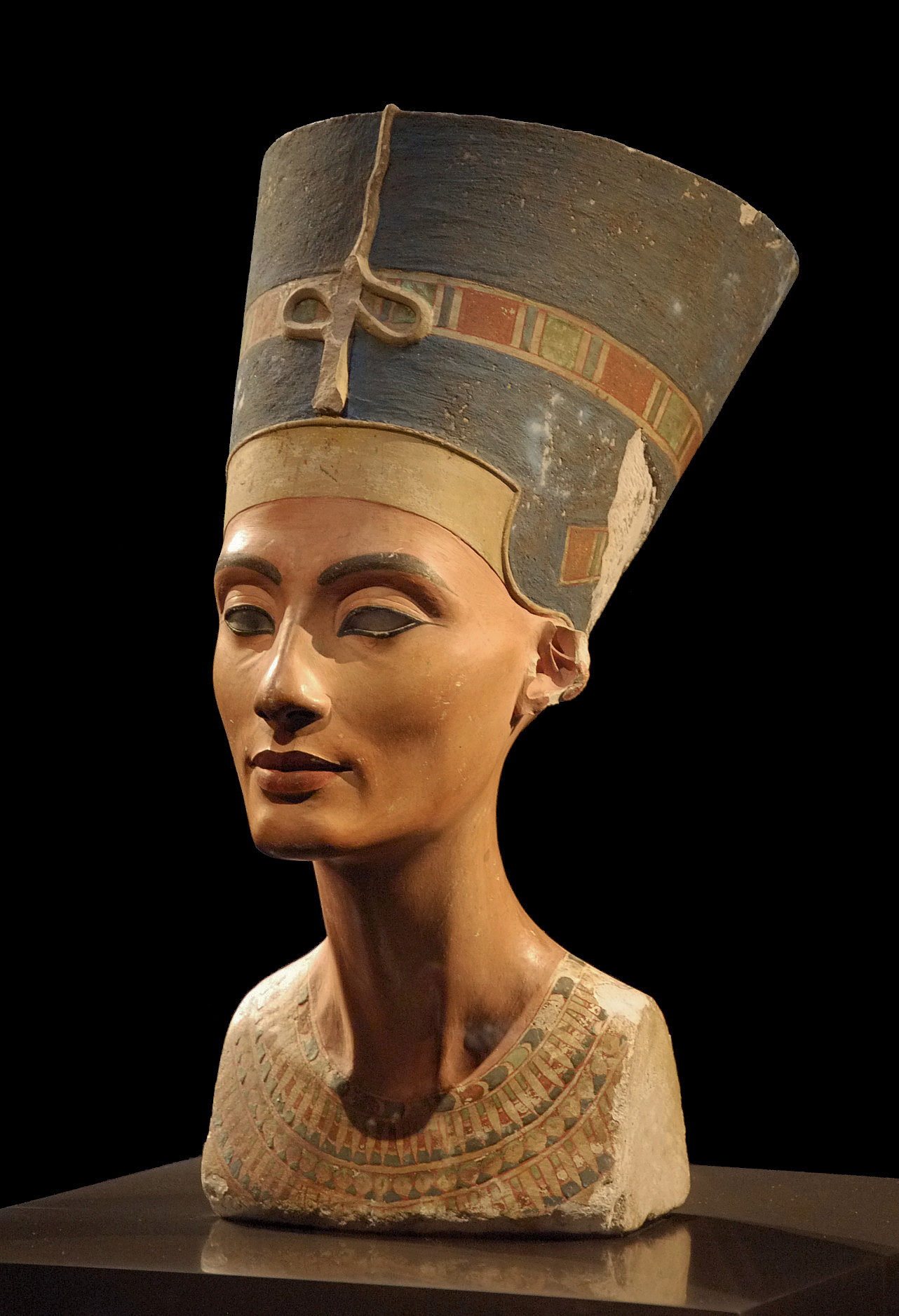
Nefertiti bust, Egypt, 1353-1335 BCE (Amarna Period)
> Thutmose = creator
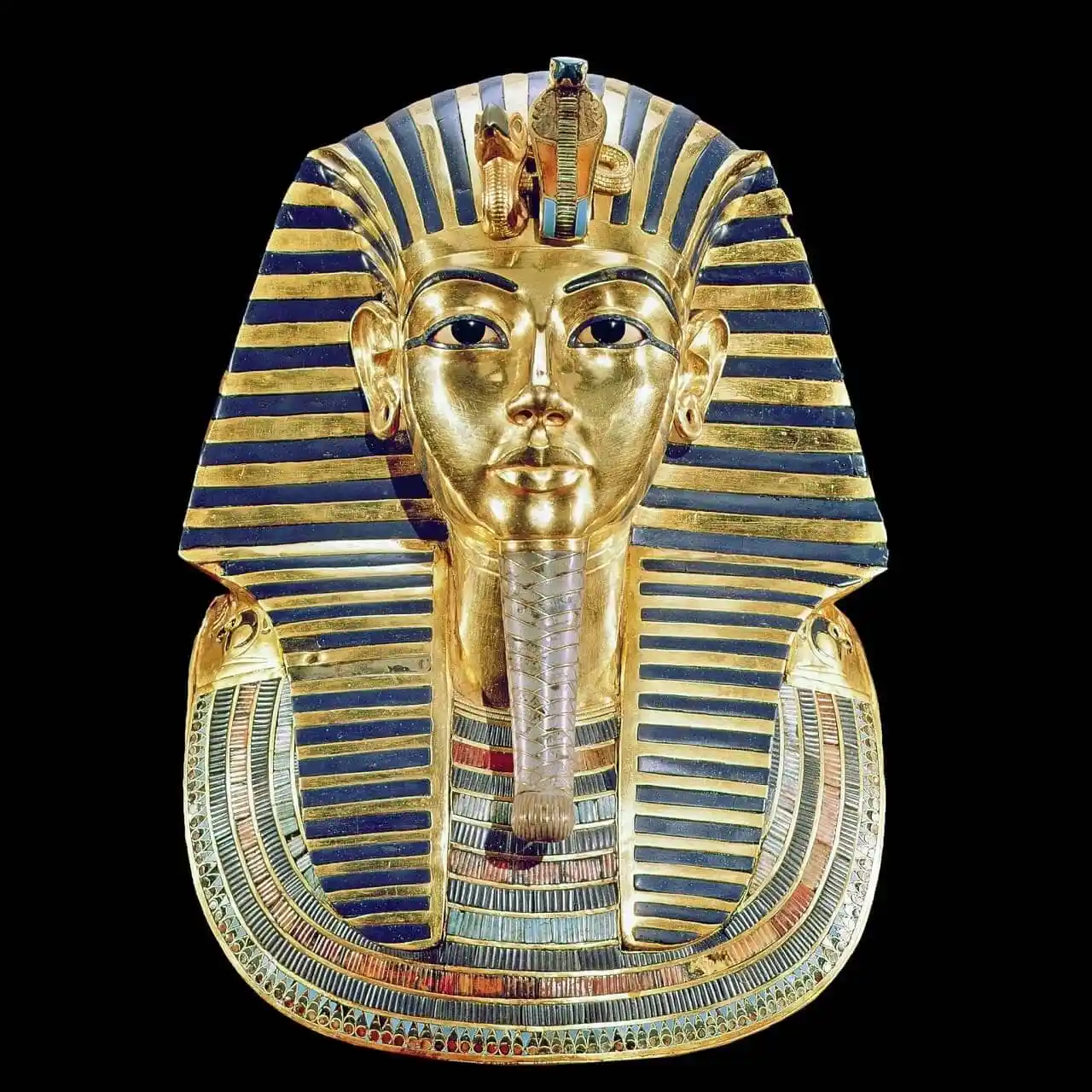
Death mask of Tutankhamun, Thebes/Egypt, 1323 BCE (New Kingdom)
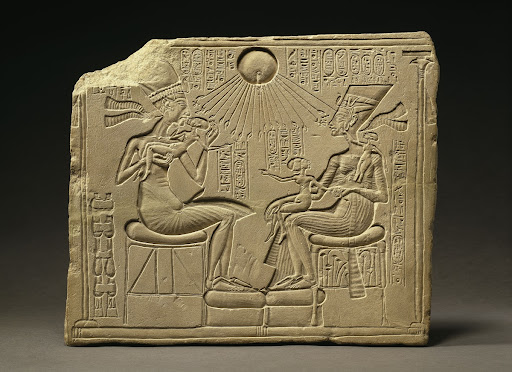
Limestone Relief of Akhenaton, Nefertiti, and 3 daughters, 1350 BCE (Amarna Period)
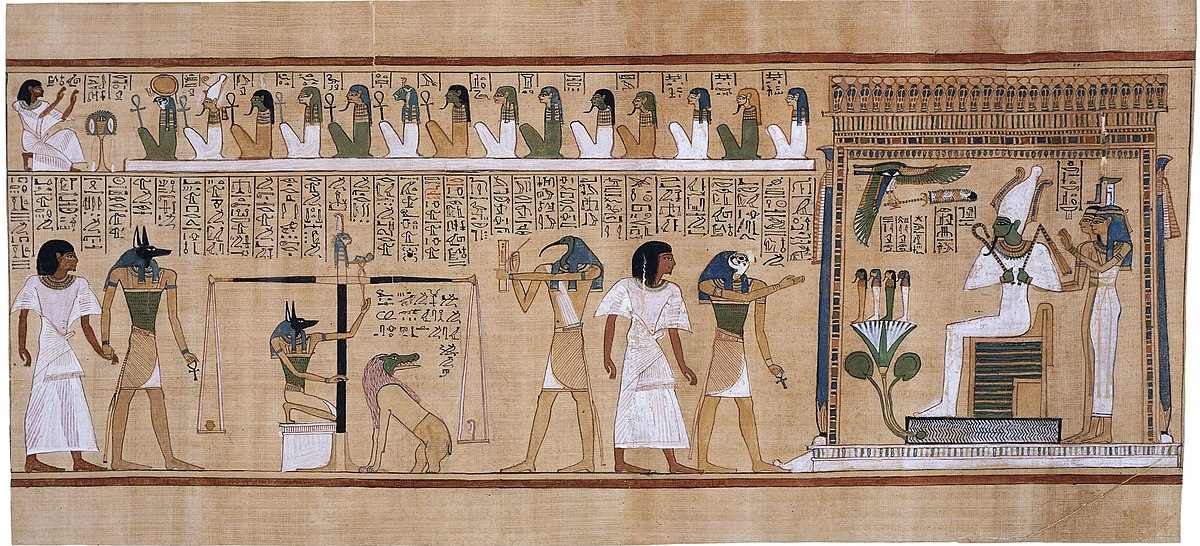
Last judgment of Hu-Nefer, Thebes/Egypt, 1290-1280 BCE (New Kingdom)
> depicts Hunefer’s soul being weighed and him being granted eternal life in afterlife
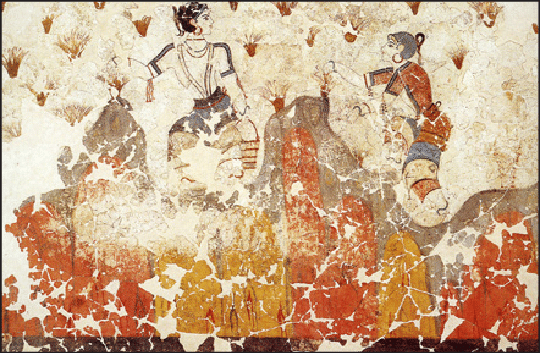
Crocus Gatherers, Thera/Santorini, 1650 BCE (Prehistoric Aegean)
> some ¾ view, greater variety in form, movement
> Minoans 🤝 landscapes
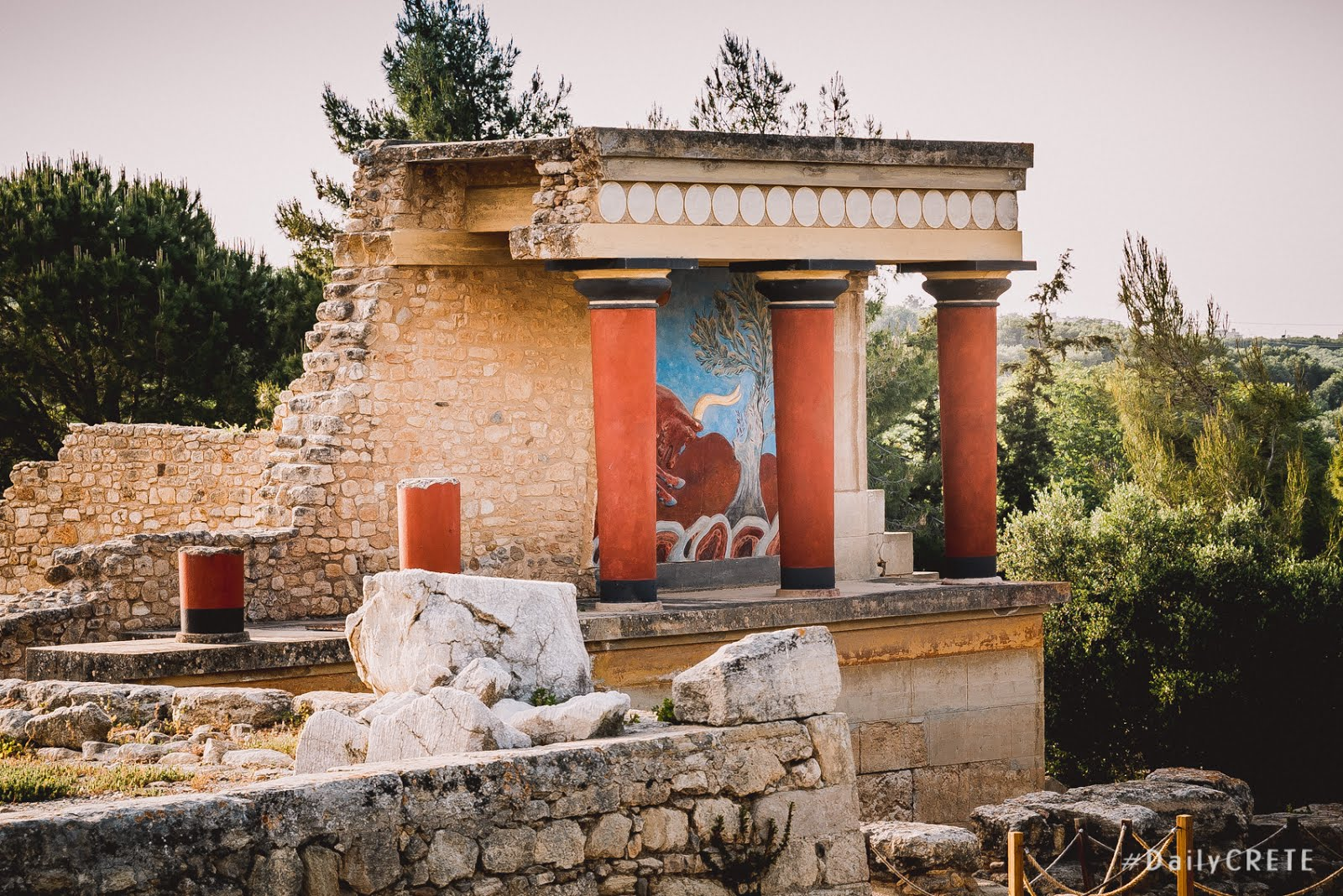
Palace of Knossos, Crete, 1700-1370 BCE (Prehistoric Aegean)
> labrynthine structure, lots of corridors (think Minotaur myth)
> one large courtyard, typical of Minoan palaces
> big red pillars taper towards bottom, Doric-ish
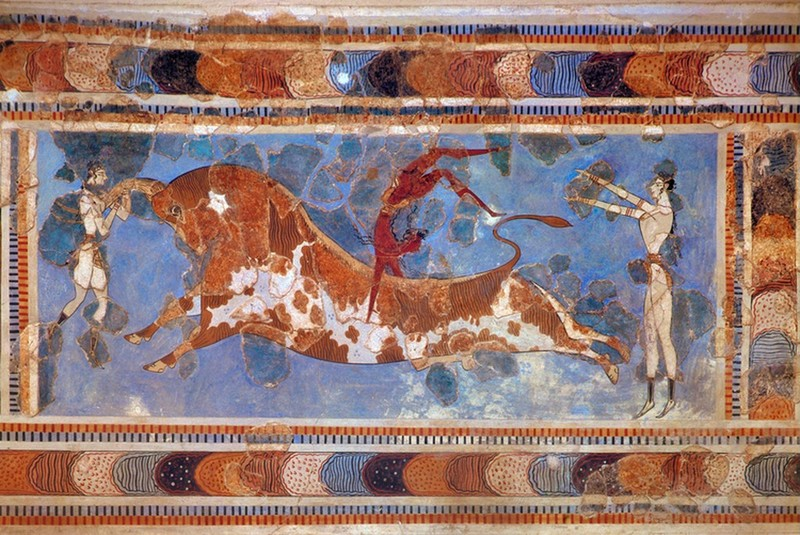
Bull-leaping, Knossos, Crete, 1450-1400 BCE (Prehistoric Aegean)
> dark-skin = men, light skin = women
> highly stylized, Minoan-typical thin waists
> elastic pose
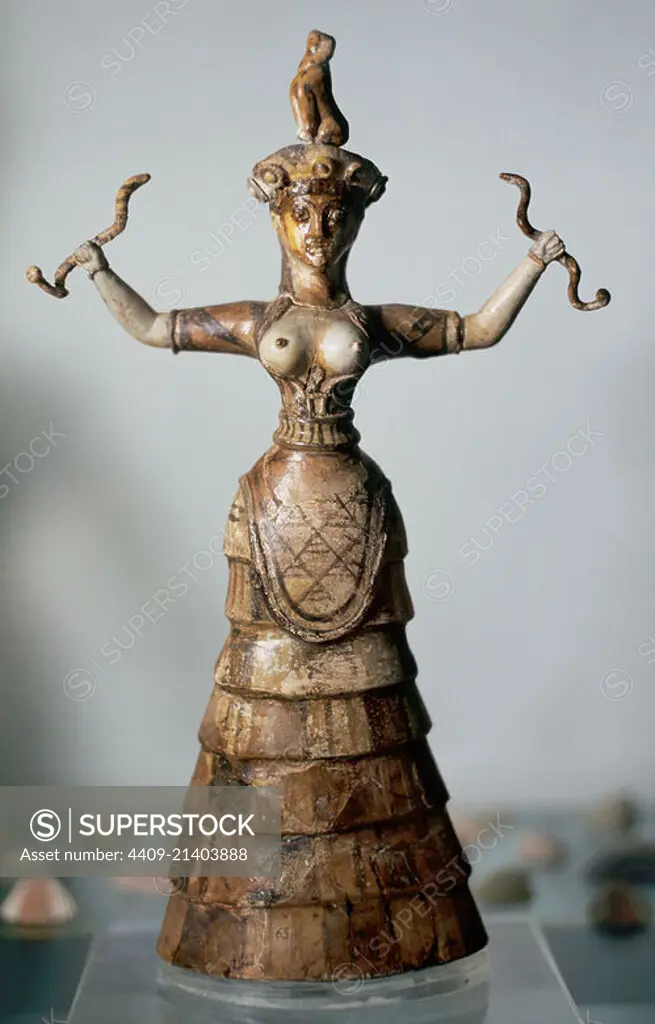
Snake Goddess, Knossos, Crete, 1600 BCE (Prehistoric Aegean)
> snakes = good luck, fertility, renewal
> possibly a priestess
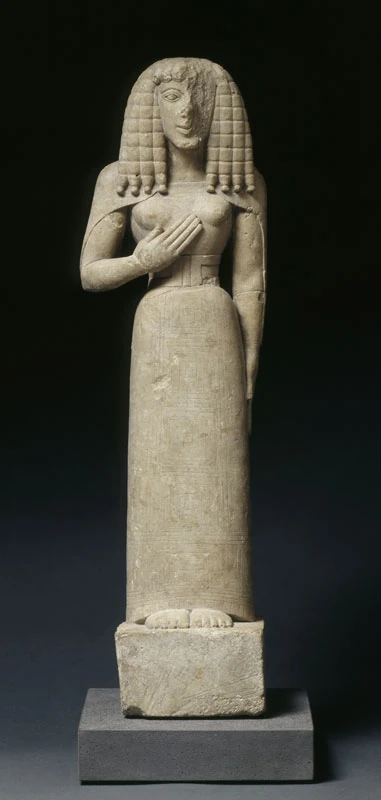
Lady of Auxerre, Greece (idk city), 650-625 BCE (Geometric Period)
> Daedalic style: stylized almond eyes and triangly face
> clothed
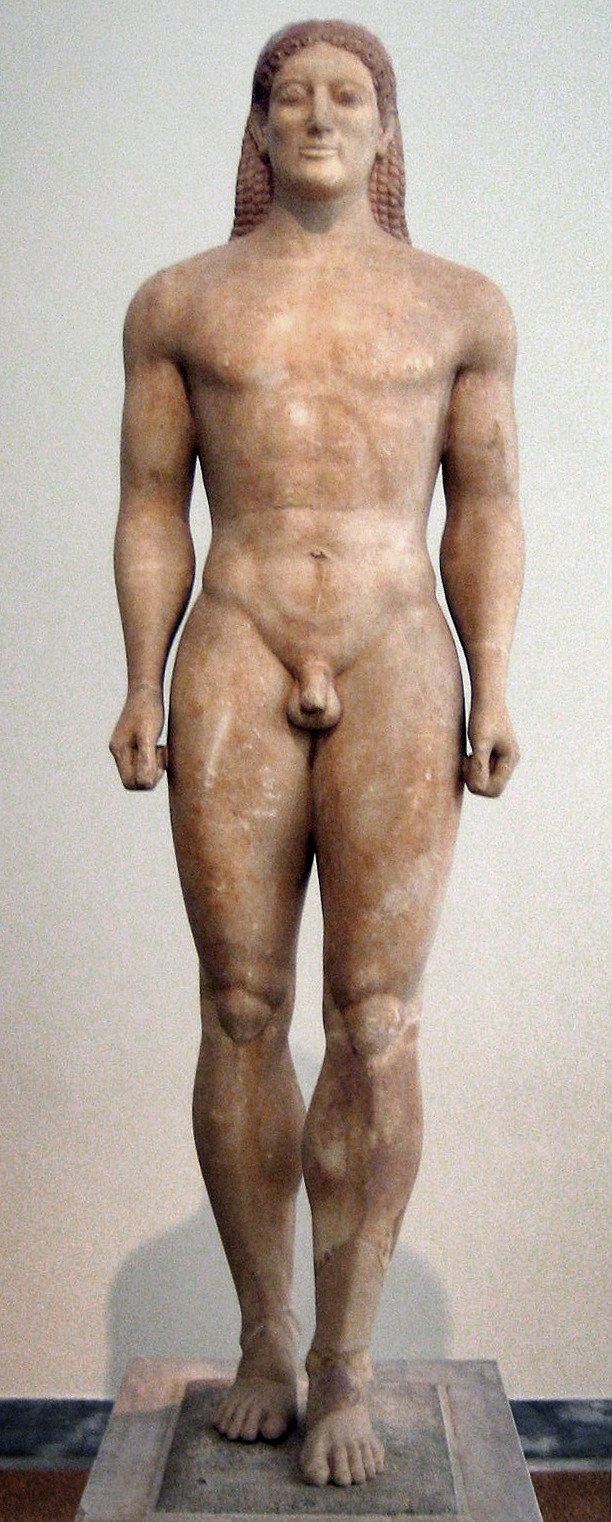
Kroisos, Anavysos, 530 BCE (Archaic)
> inscribed funerary marker, killed in war
> left foot out in Egyptian pose
> heroic nudity, more naturalistic

Temple of Artemis pediment, Corfu, 600-580 BCE (Archaic)
> earliest example of Archaic temple
> nonchronological details so we can detail Medusa in center
> warding off evil
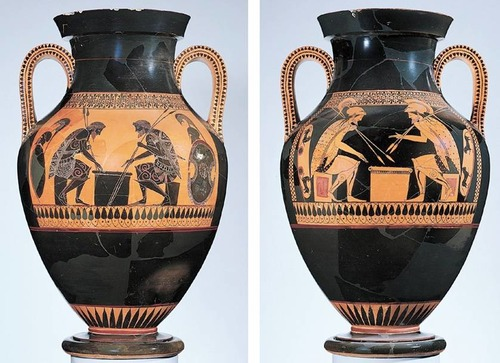
Bilingual amphora with Achilles and Ajax, Orvieto, 525-520 BCE (Archaic)
> bilingual = one side is black figure, the other is red figure
> painter: Andokides
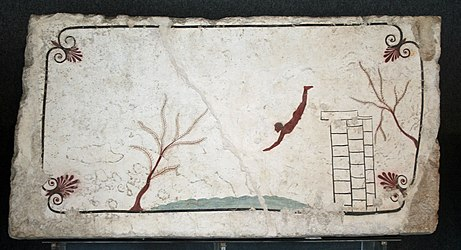
Tomb of the Diver, Paestum, 480 BCE (Early Classical)
> taking plunge into underworld
> would have been on ceiling of the tomb
> compare to Etruscan Tomb of Hunting and Fishing
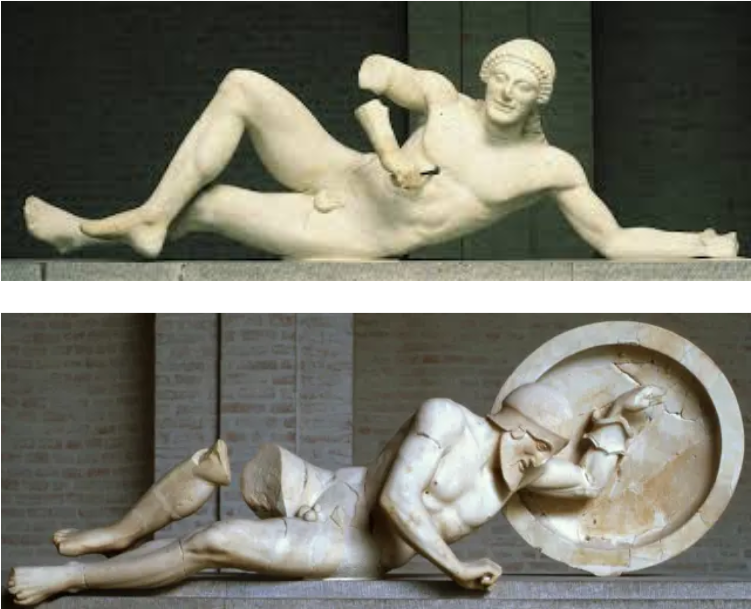
Dying warriors from pediment of Temple of Aphaia, Aegina, 500-480 BCE (Archaic and Early Classical)
> shows introduction of Early Classical self-consciousness/realism
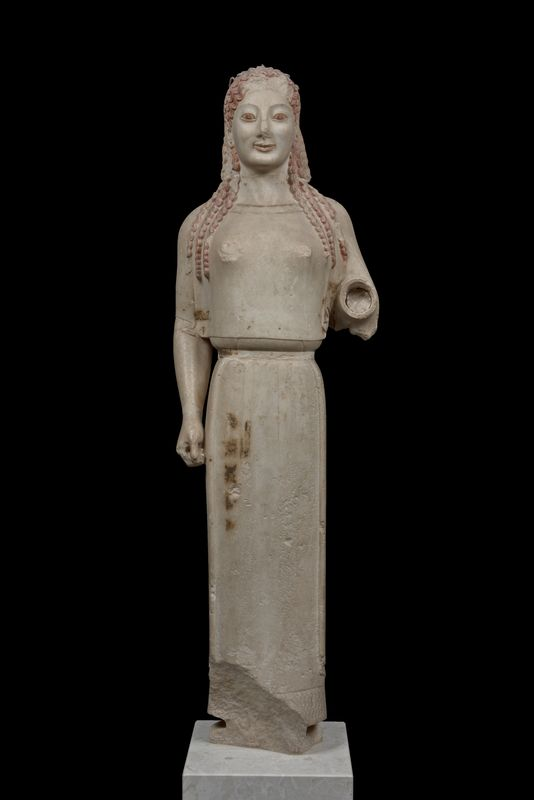
Peplos Kore, Acropolis, 530 BCE (Archaic)
> probably a goddess
> traces of paint
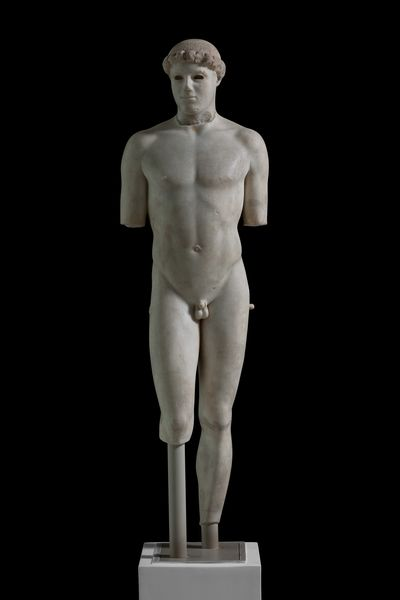
Kritios Boy, Acropolis, 480 BCE (Classical)
> earliest known example of contrapposto
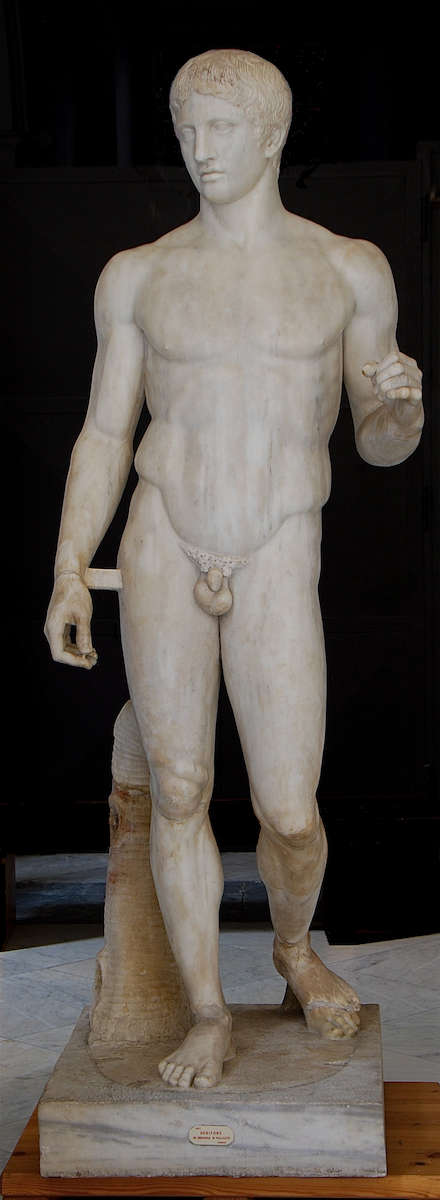
Doryphoros Spear Thrower, Pompeii, 450-440 BCE (Classical)
> made by Polykeitos: the guy who was obsessed with the mathematically perfect body
> contrapposto
> original in bronze
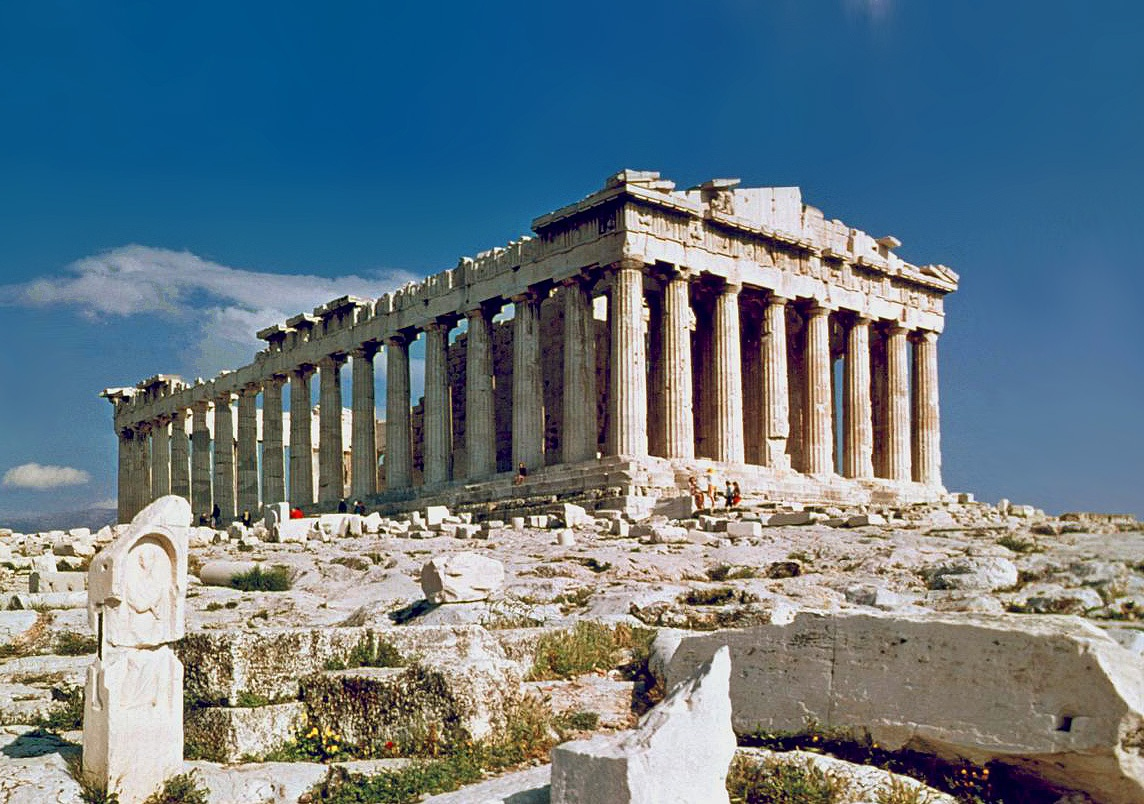
Parthenon, Athens, 447-438 BCE (Classical)
> Doric elements: capitals, triglyphs/metopes
> Ionic elements: inner colonnade, wrapped-around frieze
> housed cult image of Athena Parthenos
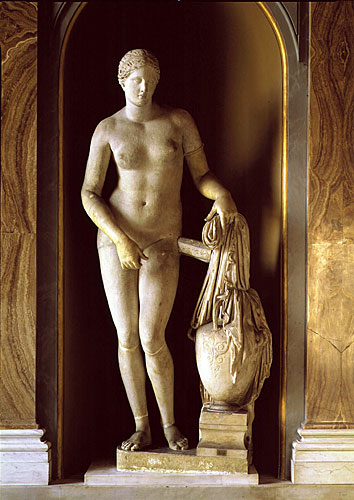
Aphrodite of Knidos, 350-340 BCE (Classical)
> Praxiteles = sculptor
> female nudity, extreme step away from tradition (though still modest)
> another marble copy of bronze
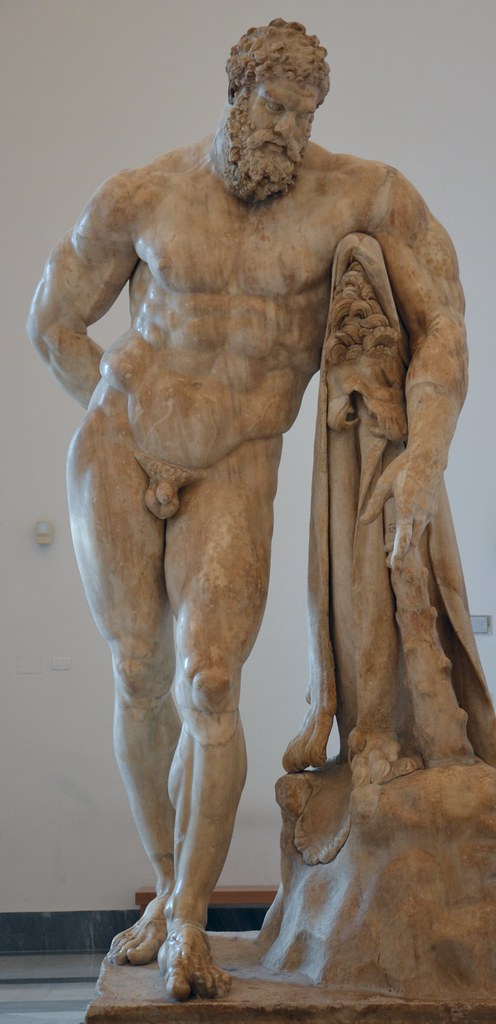
Weary/Farnese Herakles, Roman Baths of Caracalla, 320 BCE (Hellenistic)
> Lysippos = sculptor
> colossal
> small head, extremely muscular
> Hellenistic weariness and pain; humanizing demigod divinity
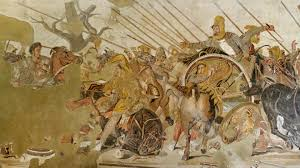
Alexander Mosaic, Pompeii, 100 BCE (Hellenistic)
> copy of Greek painting of Battle of Issus
> underdog Alexander - characteristic big eyes
> showing off twisted poses, anatomy
> opus vermiculatum
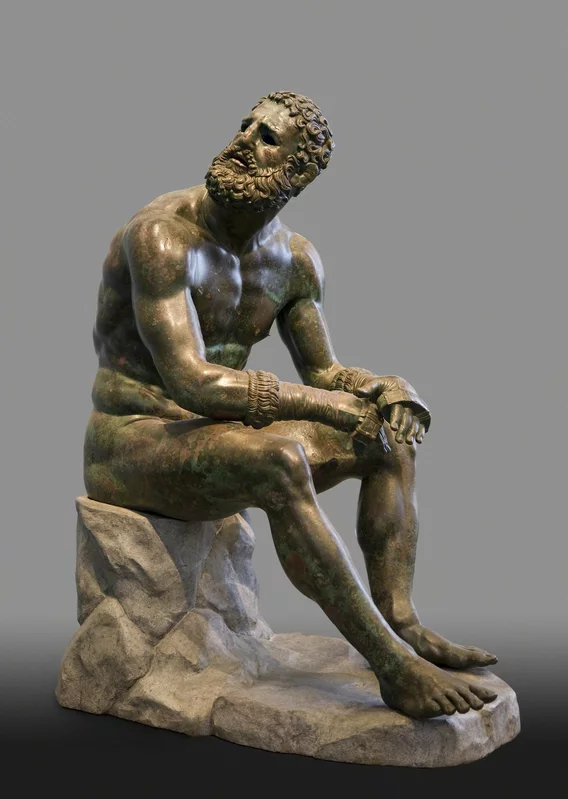
Seated Boxer, Rome, 100-50 BCE (Hellenistic)
> colossal
> typical Hellenistic pathos and suffering - boxing scars
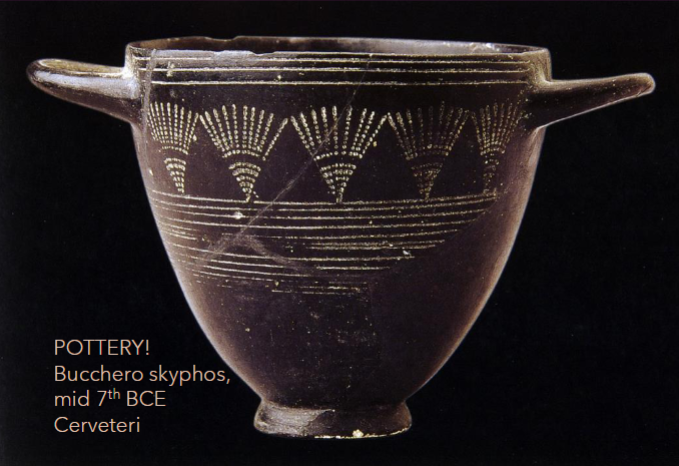
Bucchero, Etruria, 700-480 BCE (but i don’t think they’ll ask time)
> fired in reduction: less oxygen turns terra cotta’s oxides black
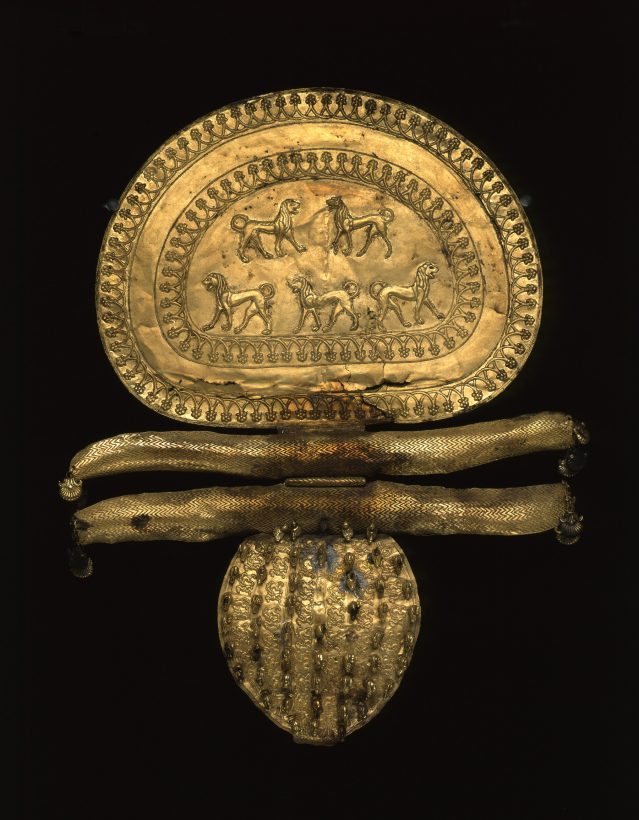
Gold Fibula, Cerveteri/Italy, 650-640 BCE (Early Etruscan)
> non-native lions — emphasized in class as example of adopting what they liked as active agents
> tiny gold ducks :)
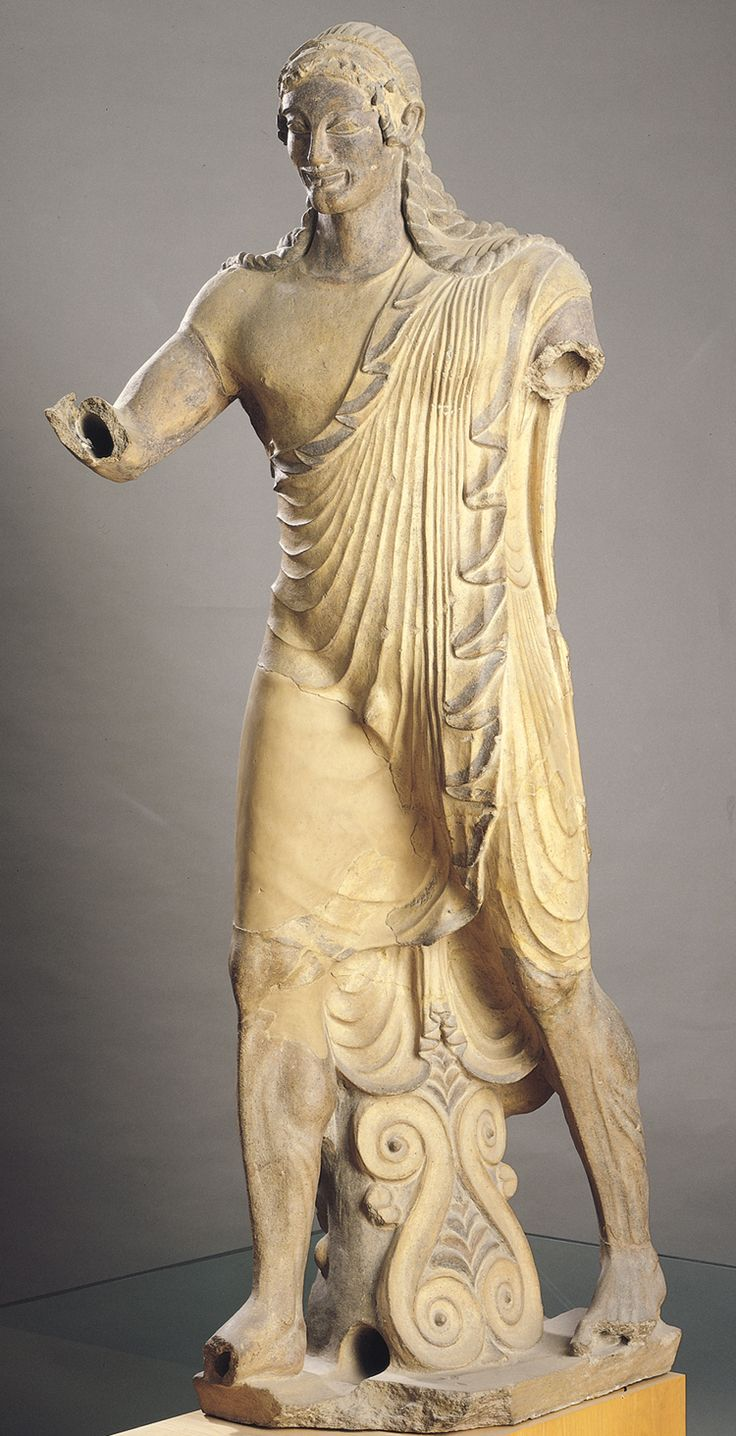
Apulu, Veii, 510-500 BCE (Early Etruscan)
> would have been on temple roof as part of a narrative
> motion, impressive fabric
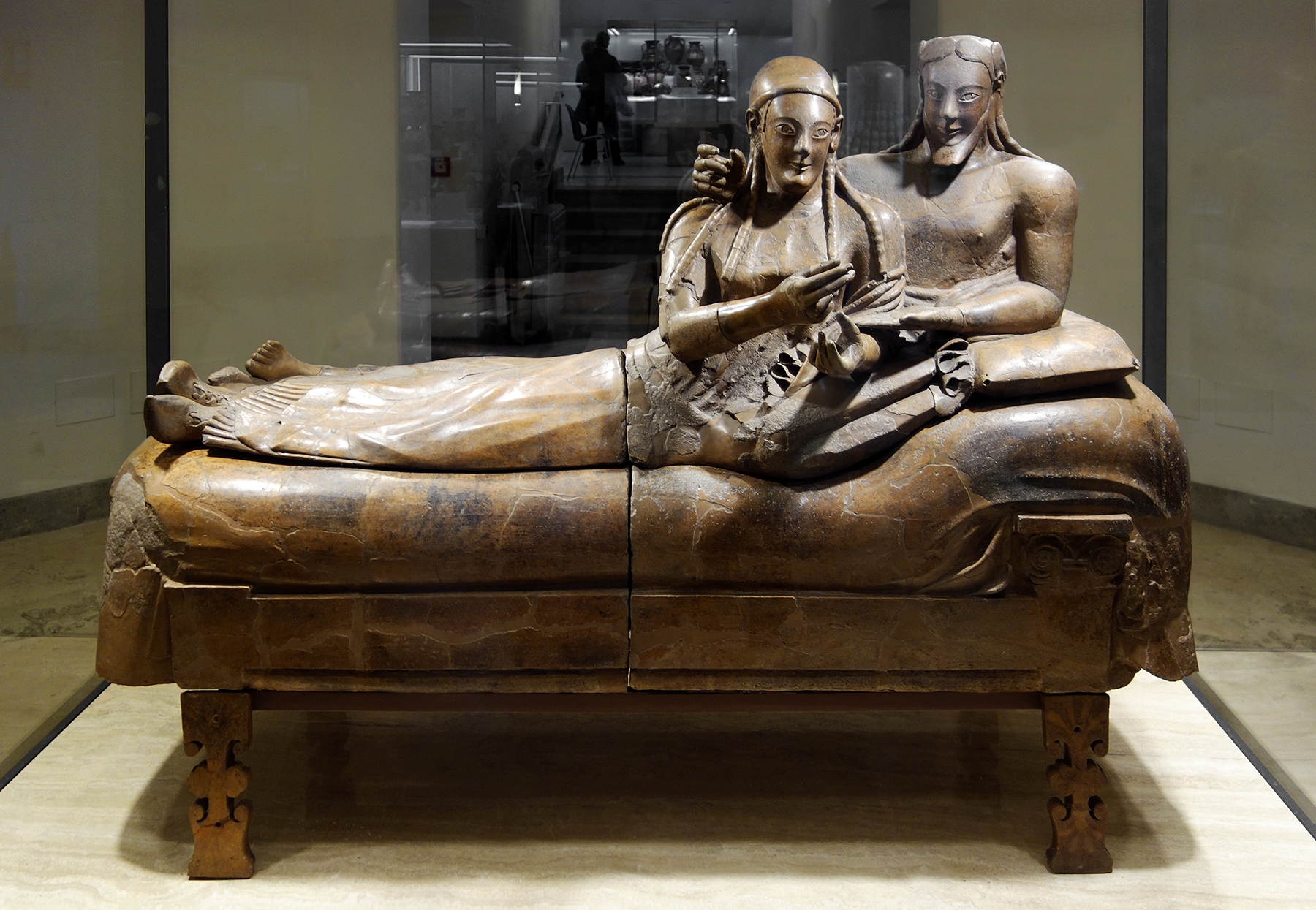
Sarcophagus with reclining couple, Cerveteri, 520 BCE (Early Etruscan)
> depicts banquet culture
> typical stylized almond eyes
> would have once held items
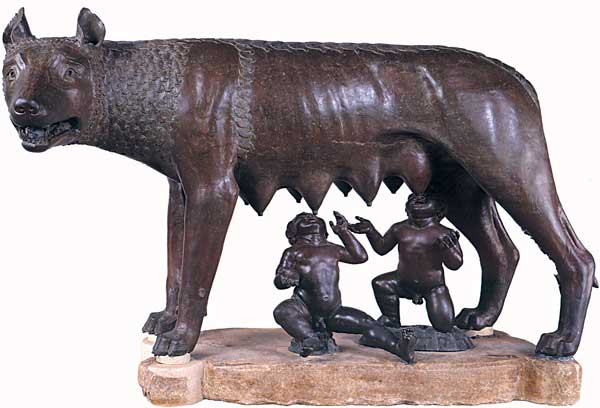
Capitoline She-Wolf, 500-480 BCE (Early-Mid Etruscan)
> single-cast bronze raises questions about Medieval origins
> icon of Rome's legendary founding; political and often nationalistic symbol
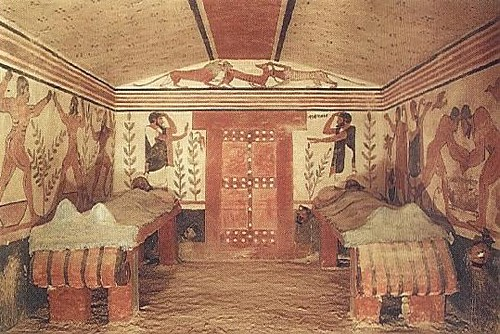
Tomb of the Augurs, Tarquinia, 530-520 BCE (Early Etruscan)
> symbolic door at back of the tomb to represent afterlife
> walls depict funerary games, wrestling, luscious lashes
> composite view of faces
> no women
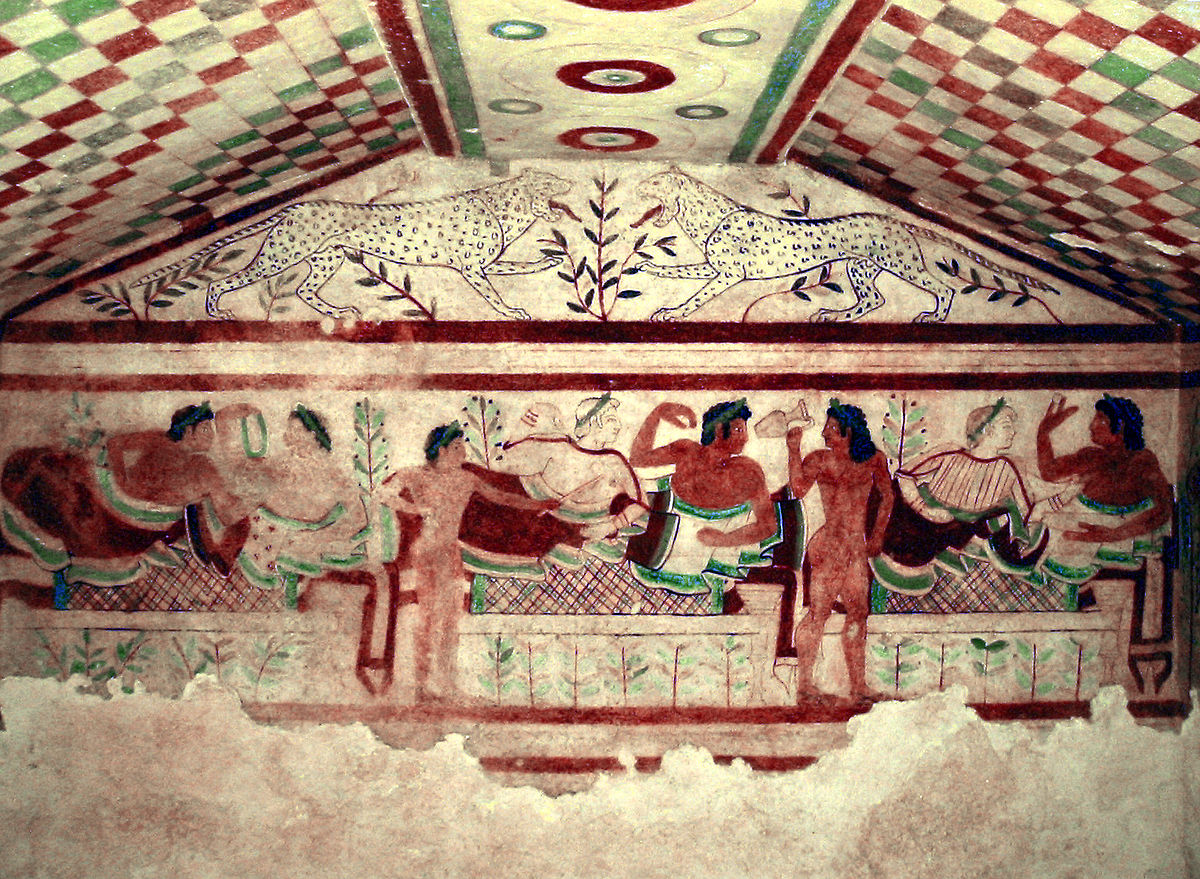
Tomb of the Leopards, Tarquinia, 480-470 BCE (Mid Etruscan)
> banquet scene on back wall, leopards on pediment
> banqueter holding egg = life
> light skin = women convention
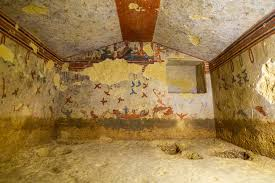
Tomb of the Hunting and Fishing, Tarquinia, 530-520 BCE (Early Etruscan)
> earliest landscape painting in all Italy
> sort of narrative, with hunter and birds. also has the diver
> harmony between man and nature
> inspires Roman landscapes later
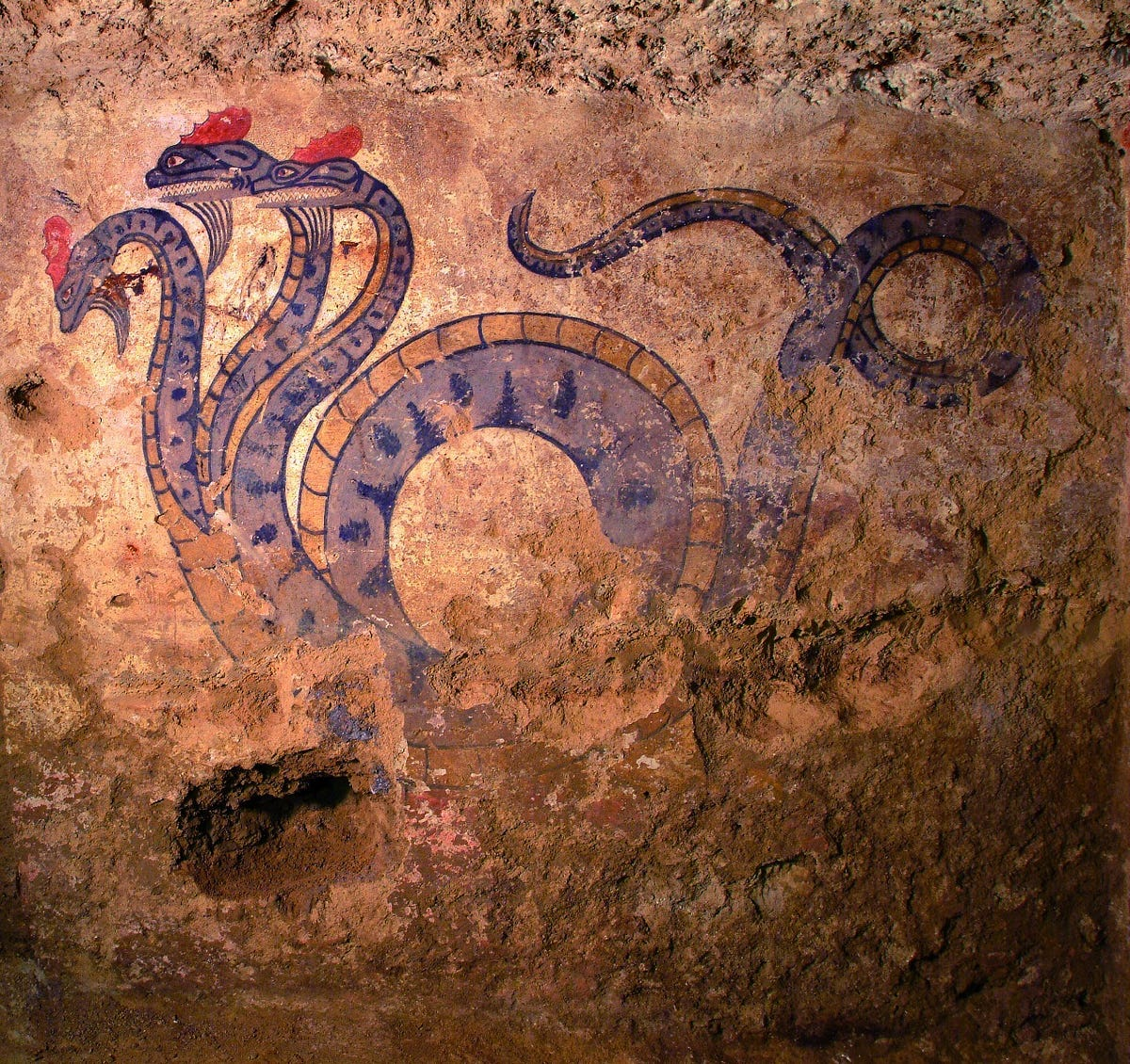
Three-Headed Serpent, Tomb of the Infernal Quadriga in Sarteano/Italy, c. 400 BCE (Mid Etruscan)
> rad tomb name
> warding off evil or tomb raiders
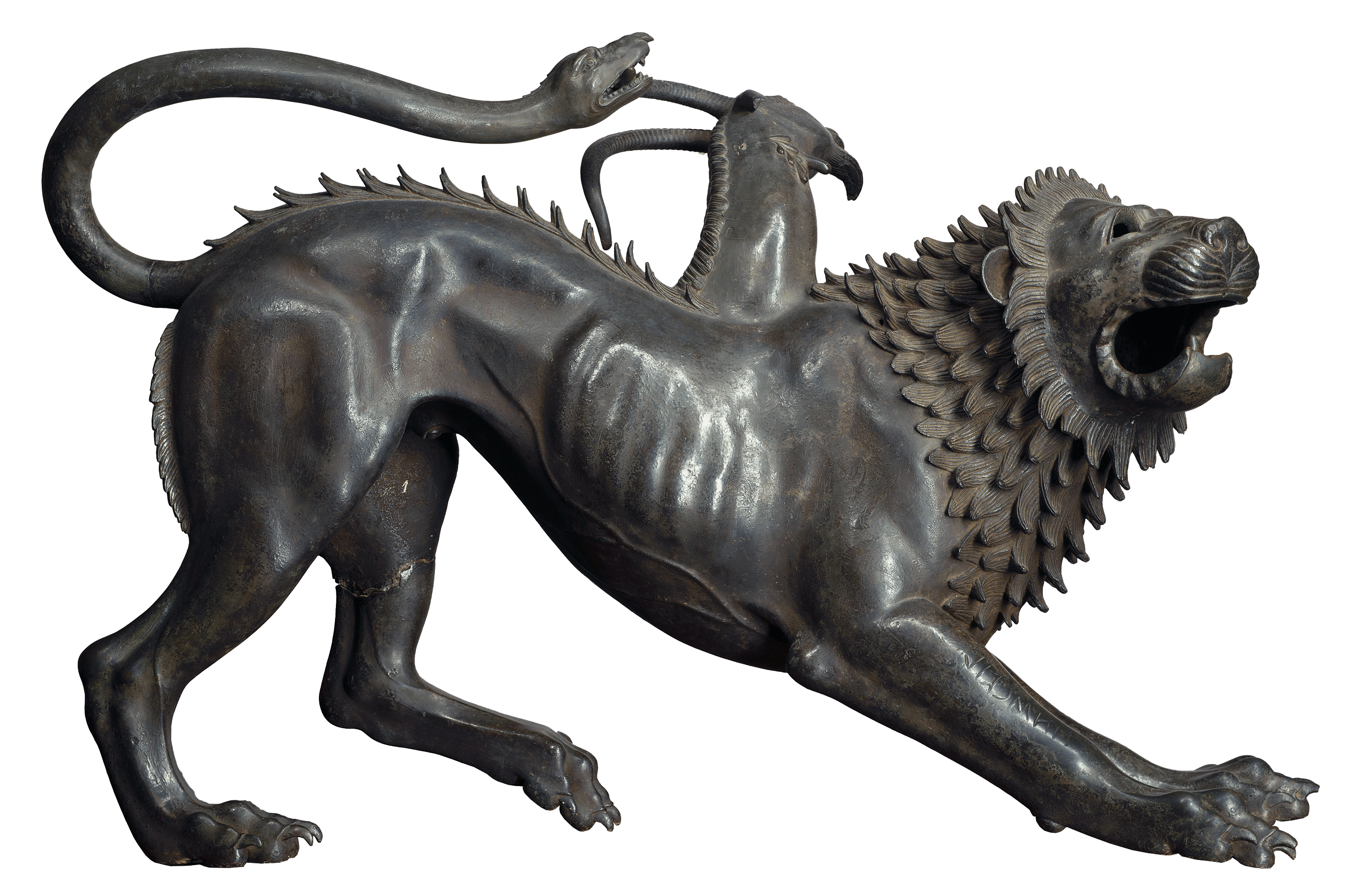
Chimera of Arezzo, 350 BCE (Mid Etruscan)
> votive to Zeus
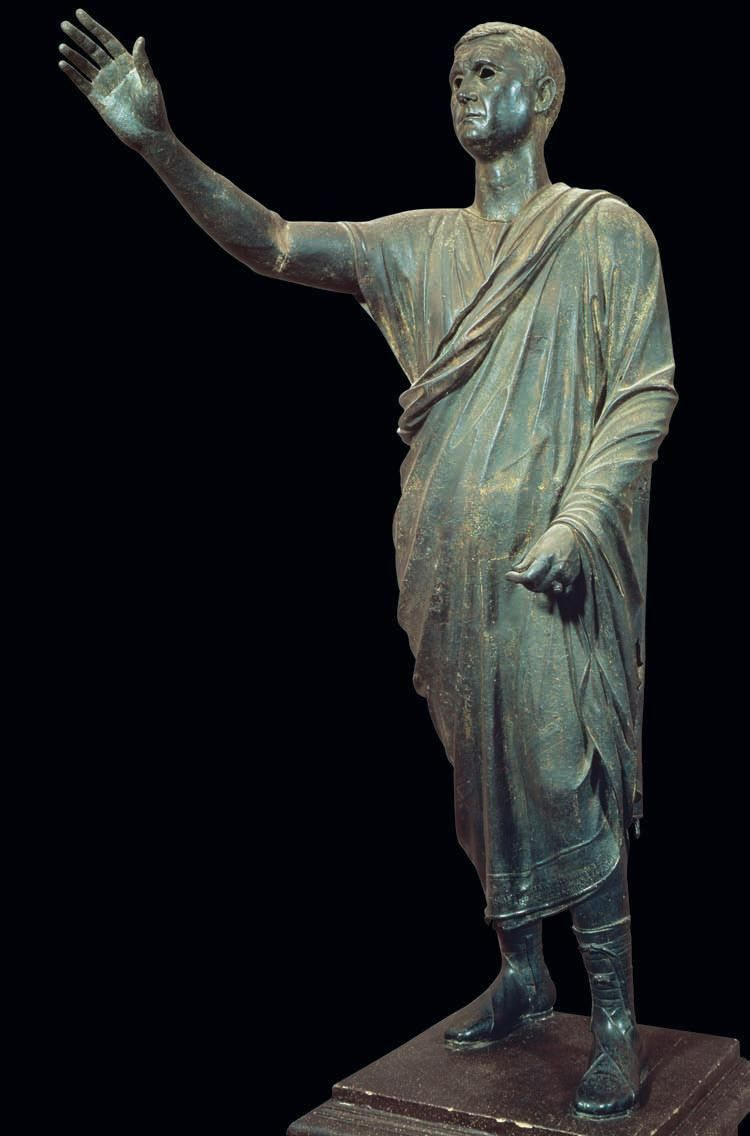
Aule Metele, Cortona, 100 BCE (Late Etruscan)
> Romanized Etruscan, post-colonization (haircut, toga, no beard)
> the orator “hey listen up” hand

Sanctuary of Fortuna, Palestrina, late 2nd century BCE (110ish, Roman Republic)
> nature succumbs to human design, built out of the hill
> compare to Temple of Hatshepsut
> opus incertum - cobblestone sort of lack of pattern
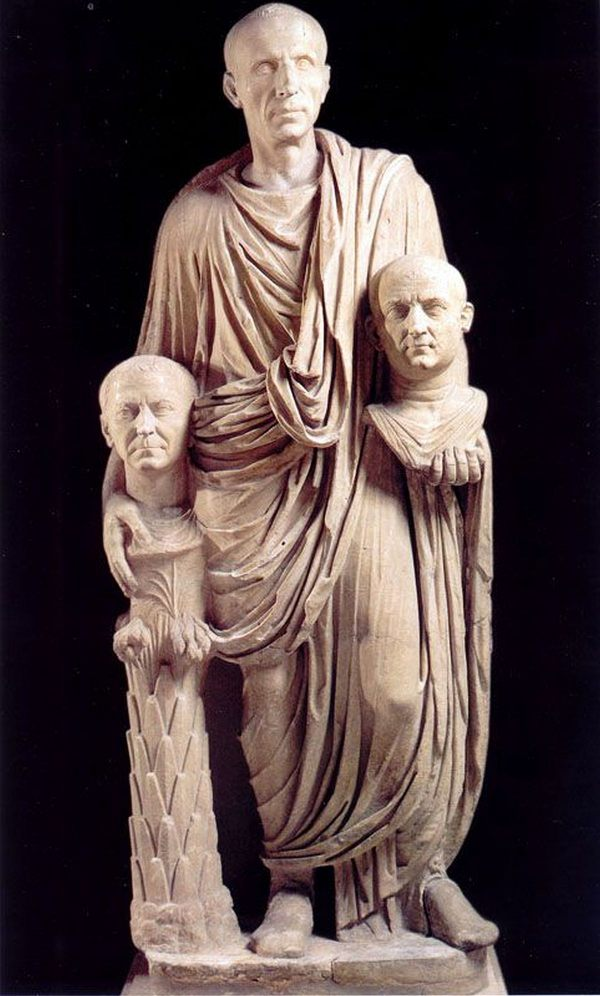
Man with portrait busts of ancestors, 1st century BCE (Roman Republic)
> busts likely represent commemorative masks
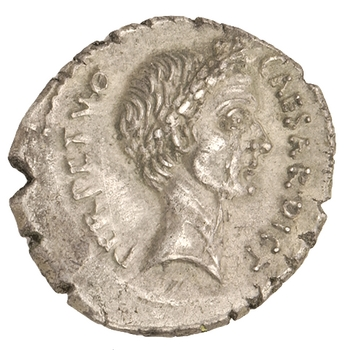
Denarius of Julius Caesar, Rome, 44 BCE (Roman Republic)
> first time a Roman ruler had ever put his face on a coin — it was a space reserved for gods
> “Caesar dict perpetuo”
> veristic realism, true to his age
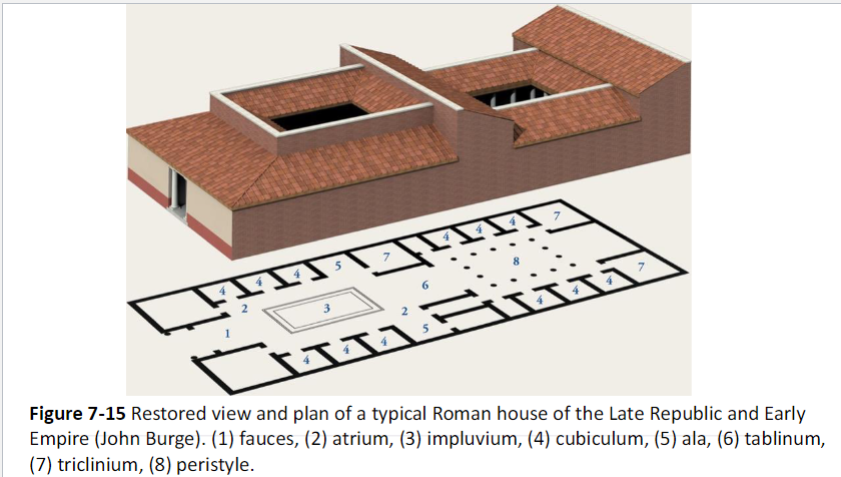
i know you can literally read the answer but i’m too lazy to edit it out
Restored plan of a Roman house (Late Republic, Early Empire)
> i don’t think she went over this one in class lol
> impluvia were cool though! they collected rainwater. (in + pluvia = in + rain)
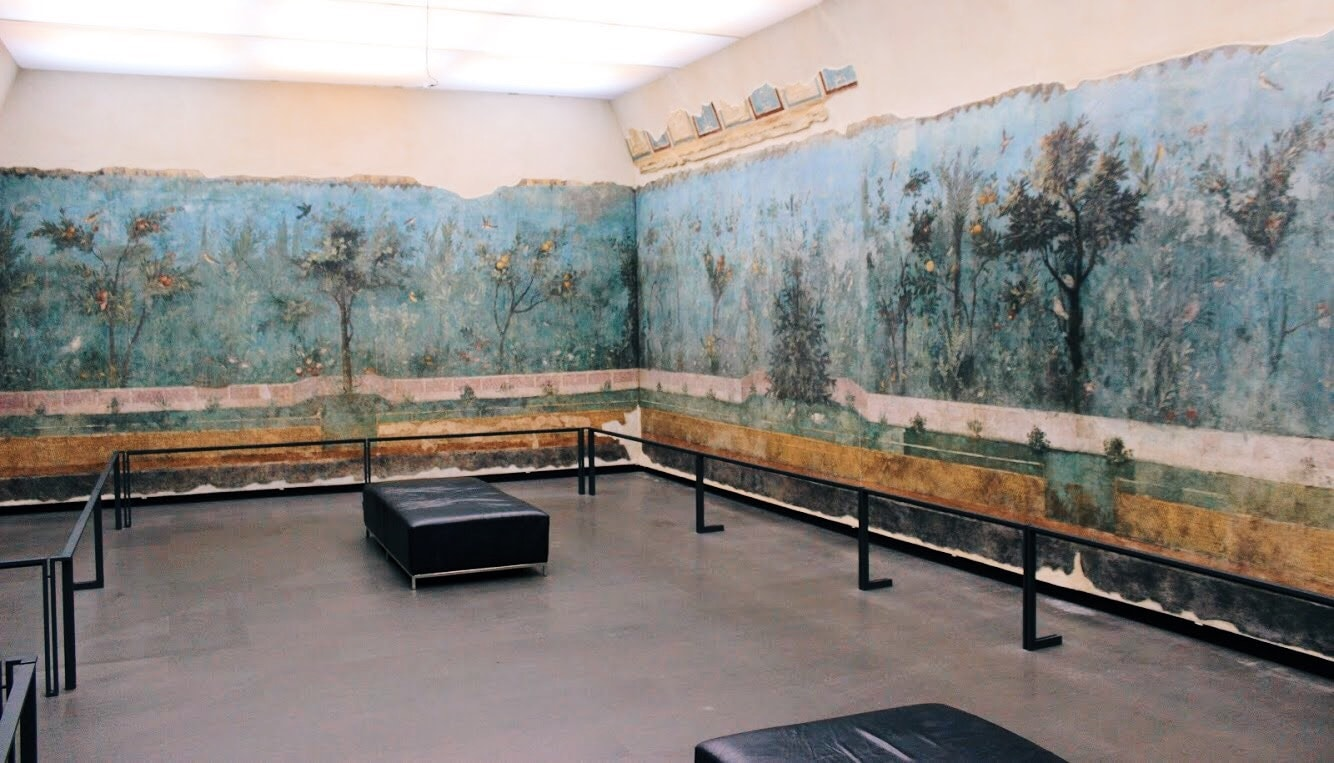
Gardenscape from the Villa of Livia, Primaporta, 30-20 BCE (Imperial Rome)
> Second Style
> anachronistic blossoms
> wall = humanity controlling nature
> compare to Etruscan landscapes
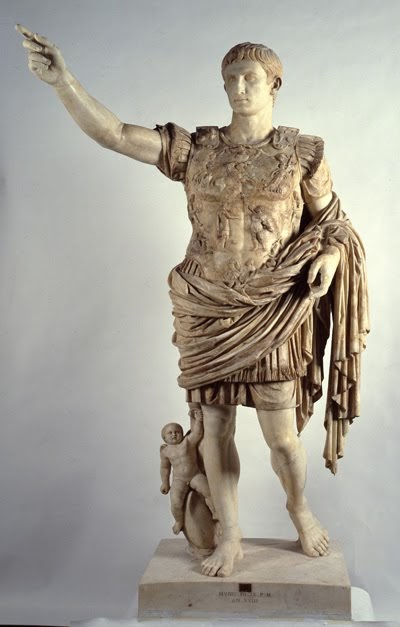
Portrait of Augustus, Primaporta, 20 BCE (Imperial Rome)
> orator’s pose
> Cupid at his side to remind us of his Aeneas/Venus descendancy
> Caelus, Sol, Luna at top of breastplate
> Parthian or maybe goddess returning Roman eagle standard
> Tellus with babies to represent fertility
> Diana on stag, Apollo on griffin
> captives on either side
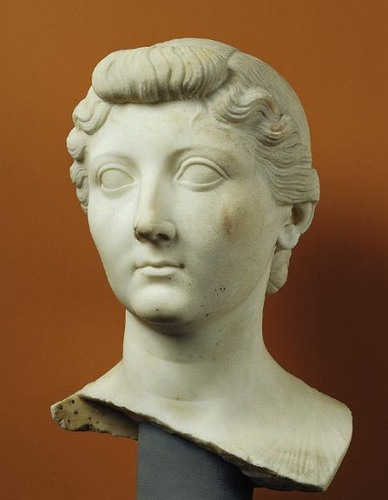
Portrait of Livia, Egypt, 1st century BCE (Imperial Rome)
> signature curled bangs
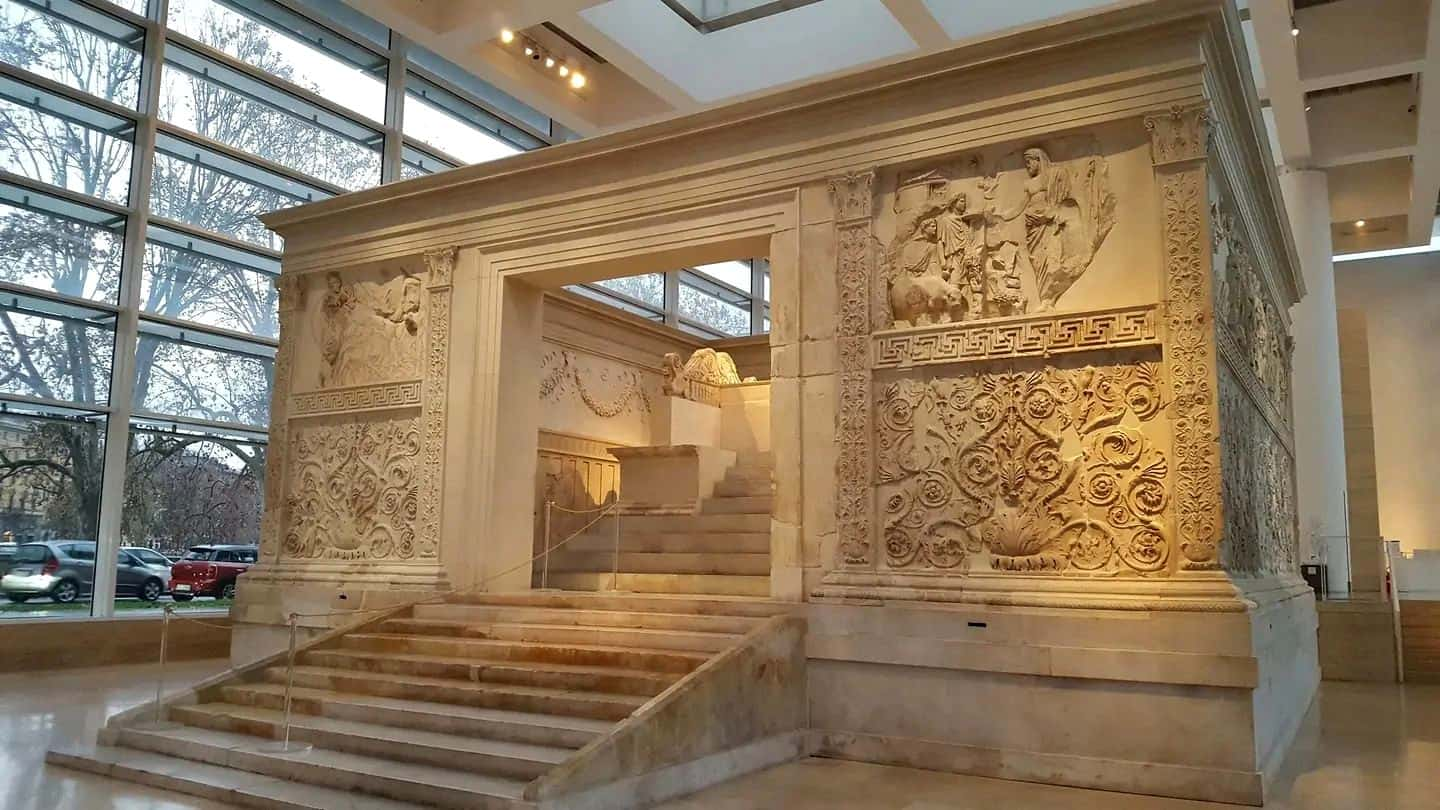
Ara Pacis, Rome, 13-9 BCE (Imperial Rome)
> gift to Augustus for his war success
> evokes 5th century Classical Greek art
> massive, super detailed florals in low-relief
> famous south frieze: Procession of the imperial family (pretty Etruscan sort of procession)
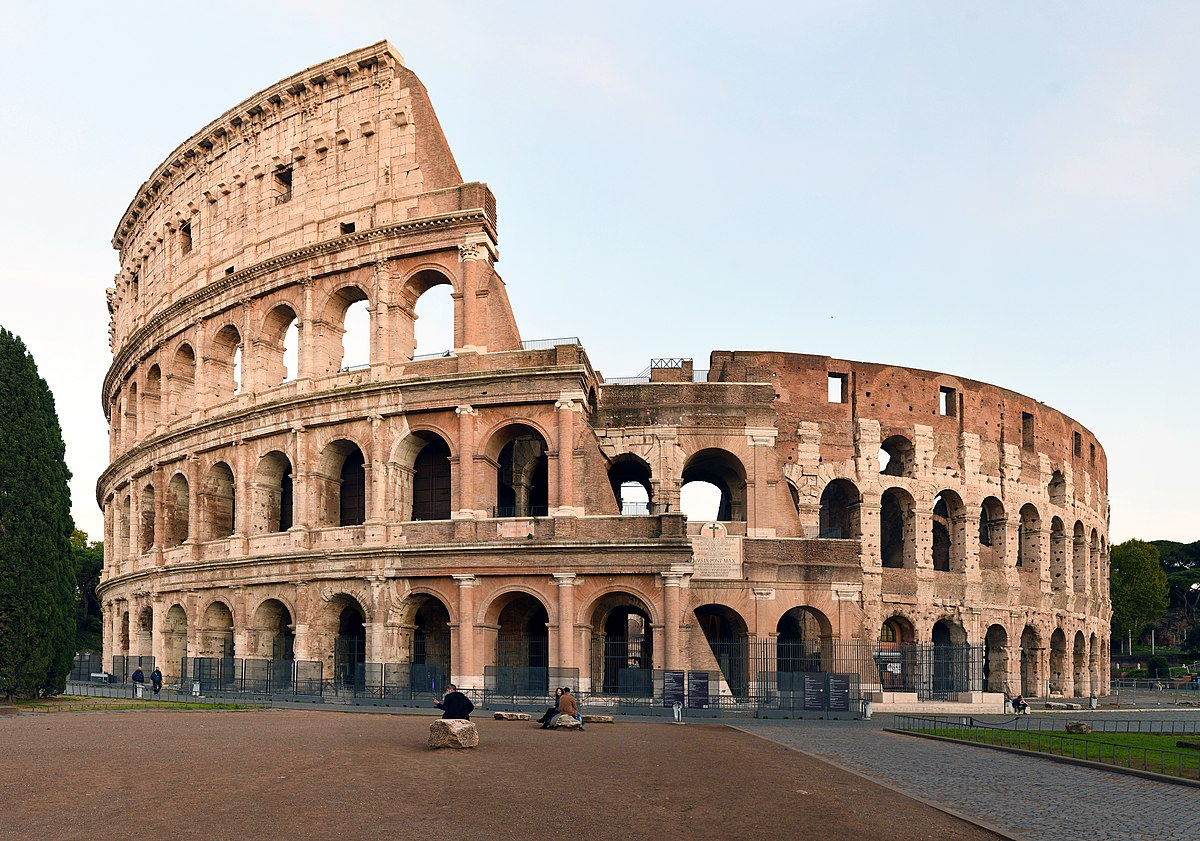
Colosseum (Flavian Amphitheater), 70-80 CE (Imperial Rome)
> built on top of Nero’s old drained lake — way of establishing power over old rulers
> faced with travertine and marble
> famous use of Roman arches